A Short Guide to Close Reading for Literary Analysis
Use the guidelines below to learn about the practice of close reading.
When your teachers or professors ask you to analyze a literary text, they often look for something frequently called close reading. Close reading is deep analysis of how a literary text works; it is both a reading process and something you include in a literary analysis paper, though in a refined form.
Fiction writers and poets build texts out of many central components, including subject, form, and specific word choices. Literary analysis involves examining these components, which allows us to find in small parts of the text clues to help us understand the whole. For example, if an author writes a novel in the form of a personal journal about a character’s daily life, but that journal reads like a series of lab reports, what do we learn about that character? What is the effect of picking a word like “tome” instead of “book”? In effect, you are putting the author’s choices under a microscope.
The process of close reading should produce a lot of questions. It is when you begin to answer these questions that you are ready to participate thoughtfully in class discussion or write a literary analysis paper that makes the most of your close reading work.
Close reading sometimes feels like over-analyzing, but don’t worry. Close reading is a process of finding as much information as you can in order to form as many questions as you can. When it is time to write your paper and formalize your close reading, you will sort through your work to figure out what is most convincing and helpful to the argument you hope to make and, conversely, what seems like a stretch. This guide imagines you are sitting down to read a text for the first time on your way to developing an argument about a text and writing a paper. To give one example of how to do this, we will read the poem “Design” by famous American poet Robert Frost and attend to four major components of literary texts: subject, form, word choice (diction), and theme.
If you want even more information about approaching poems specifically, take a look at our guide: How to Read a Poem .
As our guide to reading poetry suggests, have a pencil out when you read a text. Make notes in the margins, underline important words, place question marks where you are confused by something. Of course, if you are reading in a library book, you should keep all your notes on a separate piece of paper. If you are not making marks directly on, in, and beside the text, be sure to note line numbers or even quote portions of the text so you have enough context to remember what you found interesting.
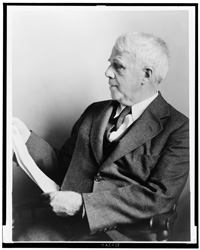
Design I found a dimpled spider, fat and white, On a white heal-all, holding up a moth Like a white piece of rigid satin cloth— Assorted characters of death and blight Mixed ready to begin the morning right, Like the ingredients of a witches’ broth— A snow-drop spider, a flower like a froth, And dead wings carried like a paper kite. What had that flower to do with being white, The wayside blue and innocent heal-all? What brought the kindred spider to that height, Then steered the white moth thither in the night? What but design of darkness to appall?— If design govern in a thing so small.
The subject of a literary text is simply what the text is about. What is its plot? What is its most important topic? What image does it describe? It’s easy to think of novels and stories as having plots, but sometimes it helps to think of poetry as having a kind of plot as well. When you examine the subject of a text, you want to develop some preliminary ideas about the text and make sure you understand its major concerns before you dig deeper.

Observations
In “Design,” the speaker describes a scene: a white spider holding a moth on a white flower. The flower is a heal-all, the blooms of which are usually violet-blue. This heal-all is unusual. The speaker then poses a series of questions, asking why this heal-all is white instead of blue and how the spider and moth found this particular flower. How did this situation arise?
The speaker’s questions seem simple, but they are actually fairly nuanced. We can use them as a guide for our own as we go forward with our close reading.
- Furthering the speaker’s simple “how did this happen,” we might ask, is the scene in this poem a manufactured situation?
- The white moth and white spider each use the atypical white flower as camouflage in search of sanctuary and supper respectively. Did these flora and fauna come together for a purpose?
- Does the speaker have a stance about whether there is a purpose behind the scene? If so, what is it?
- How will other elements of the text relate to the unpleasantness and uncertainty in our first look at the poem’s subject?
After thinking about local questions, we have to zoom out. Ultimately, what is this text about?
Form is how a text is put together. When you look at a text, observe how the author has arranged it. If it is a novel, is it written in the first person? How is the novel divided? If it is a short story, why did the author choose to write short-form fiction instead of a novel or novella? Examining the form of a text can help you develop a starting set of questions in your reading, which then may guide further questions stemming from even closer attention to the specific words the author chooses. A little background research on form and what different forms can mean makes it easier to figure out why and how the author’s choices are important.
Most poems follow rules or principles of form; even free verse poems are marked by the author’s choices in line breaks, rhythm, and rhyme—even if none of these exists, which is a notable choice in itself. Here’s an example of thinking through these elements in “Design.”
In “Design,” Frost chooses an Italian (or Petrarchan) sonnet form: fourteen lines in iambic pentameter consisting of an octave (a stanza of eight lines) and a sestet (a stanza of six lines). We will focus on rhyme scheme and stanza structure rather than meter for the purposes of this guide. A typical Italian sonnet has a specific rhyme scheme for the octave:
a b b a a b b a
There’s more variation in the sestet rhymes, but one of the more common schemes is
c d e c d e
Conventionally, the octave introduces a problem or question which the sestet then resolves. The point at which the sonnet goes from the problem/question to the resolution is called the volta, or turn. (Note that we are speaking only in generalities here; there is a great deal of variation.)
Frost uses the usual octave scheme with “-ite”/”-ight” (a) and “oth” (b) sounds: “white,” “moth,” “cloth,” “blight,” “right,” “broth,” “froth,” “kite.” However, his sestet follows an unusual scheme with “-ite”/”-ight” and “all” sounds:
a c a a c c
Now, we have a few questions with which we can start:
- Why use an Italian sonnet?
- Why use an unusual scheme in the sestet?
- What problem/question and resolution (if any) does Frost offer?
- What is the volta in this poem?
- In other words, what is the point?
Italian sonnets have a long tradition; many careful readers recognize the form and know what to expect from his octave, volta, and sestet. Frost seems to do something fairly standard in the octave in presenting a situation; however, the turn Frost makes is not to resolution, but to questions and uncertainty. A white spider sitting on a white flower has killed a white moth.
- How did these elements come together?
- Was the moth’s death random or by design?
- Is one worse than the other?
We can guess right away that Frost’s disruption of the usual purpose of the sestet has something to do with his disruption of its rhyme scheme. Looking even more closely at the text will help us refine our observations and guesses.
Word Choice, or Diction
Looking at the word choice of a text helps us “dig in” ever more deeply. If you are reading something longer, are there certain words that come up again and again? Are there words that stand out? While you are going through this process, it is best for you to assume that every word is important—again, you can decide whether something is really important later.
Even when you read prose, our guide for reading poetry offers good advice: read with a pencil and make notes. Mark the words that stand out, and perhaps write the questions you have in the margins or on a separate piece of paper. If you have ideas that may possibly answer your questions, write those down, too.
Let’s take a look at the first line of “Design”:
I found a dimpled spider, fat and white
The poem starts with something unpleasant: a spider. Then, as we look more closely at the adjectives describing the spider, we may see connotations of something that sounds unhealthy or unnatural. When we imagine spiders, we do not generally picture them dimpled and white; it is an uncommon and decidedly creepy image. There is dissonance between the spider and its descriptors, i.e., what is wrong with this picture? Already we have a question: what is going on with this spider?
We should look for additional clues further on in the text. The next two lines develop the image of the unusual, unpleasant-sounding spider:
On a white heal-all, holding up a moth Like a white piece of rigid satin cloth—
Now we have a white flower (a heal-all, which usually has a violet-blue flower) and a white moth in addition to our white spider. Heal-alls have medicinal properties, as their name suggests, but this one seems to have a genetic mutation—perhaps like the spider? Does the mutation that changes the heal-all’s color also change its beneficial properties—could it be poisonous rather than curative? A white moth doesn’t seem remarkable, but it is “Like a white piece of rigid satin cloth,” or like manmade fabric that is artificially “rigid” rather than smooth and flowing like we imagine satin to be. We might think for a moment of a shroud or the lining of a coffin, but even that is awry, for neither should be stiff with death.
The first three lines of the poem’s octave introduce unpleasant natural images “of death and blight” (as the speaker puts it in line four). The flower and moth disrupt expectations: the heal-all is white instead of “blue and innocent,” and the moth is reduced to “rigid satin cloth” or “dead wings carried like a paper kite.” We might expect a spider to be unpleasant and deadly; the poem’s spider also has an unusual and unhealthy appearance.
- The focus on whiteness in these lines has more to do with death than purity—can we understand that whiteness as being corpse-like rather than virtuous?
Well before the volta, Frost makes a “turn” away from nature as a retreat and haven; instead, he unearths its inherent dangers, making nature menacing. From three lines alone, we have a number of questions:
- Will whiteness play a role in the rest of the poem?
- How does “design”—an arrangement of these circumstances—fit with a scene of death?
- What other juxtapositions might we encounter?
These disruptions and dissonances recollect Frost’s alteration to the standard Italian sonnet form: finding the ways and places in which form and word choice go together will help us begin to unravel some larger concepts the poem itself addresses.
Put simply, themes are major ideas in a text. Many texts, especially longer forms like novels and plays, have multiple themes. That’s good news when you are close reading because it means there are many different ways you can think through the questions you develop.
So far in our reading of “Design,” our questions revolve around disruption: disruption of form, disruption of expectations in the description of certain images. Discovering a concept or idea that links multiple questions or observations you have made is the beginning of a discovery of theme.
What is happening with disruption in “Design”? What point is Frost making? Observations about other elements in the text help you address the idea of disruption in more depth. Here is where we look back at the work we have already done: What is the text about? What is notable about the form, and how does it support or undermine what the words say? Does the specific language of the text highlight, or redirect, certain ideas?
In this example, we are looking to determine what kind(s) of disruption the poem contains or describes. Rather than “disruption,” we want to see what kind of disruption, or whether indeed Frost uses disruptions in form and language to communicate something opposite: design.
Sample Analysis
After you make notes, formulate questions, and set tentative hypotheses, you must analyze the subject of your close reading. Literary analysis is another process of reading (and writing!) that allows you to make a claim about the text. It is also the point at which you turn a critical eye to your earlier questions and observations to find the most compelling points, discarding the ones that are a “stretch.” By “stretch,” we mean that we must discard points that are fascinating but have no clear connection to the text as a whole. (We recommend a separate document for recording the brilliant ideas that don’t quite fit this time around.)
Here follows an excerpt from a brief analysis of “Design” based on the close reading above. This example focuses on some lines in great detail in order to unpack the meaning and significance of the poem’s language. By commenting on the different elements of close reading we have discussed, it takes the results of our close reading to offer one particular way into the text. (In case you were thinking about using this sample as your own, be warned: it has no thesis and it is easily discoverable on the web. Plus it doesn’t have a title.)
Frost’s speaker brews unlikely associations in the first stanza of the poem. The “Assorted characters of death and blight / Mixed ready to begin the morning right” make of the grotesque scene an equally grotesque mockery of a breakfast cereal (4–5). These lines are almost singsong in meter and it is easy to imagine them set to a radio jingle. A pun on “right”/”rite” slides the “characters of death and blight” into their expected concoction: a “witches’ broth” (6). These juxtapositions—a healthy breakfast that is also a potion for dark magic—are borne out when our “fat and white” spider becomes “a snow-drop”—an early spring flower associated with renewal—and the moth as “dead wings carried like a paper kite” (1, 7, 8). Like the mutant heal-all that hosts the moth’s death, the spider becomes a deadly flower; the harmless moth becomes a child’s toy, but as “dead wings,” more like a puppet made of a skull. The volta offers no resolution for our unsettled expectations. Having observed the scene and detailed its elements in all their unpleasantness, the speaker turns to questions rather than answers. How did “The wayside blue and innocent heal-all” end up white and bleached like a bone (10)? How did its “kindred spider” find the white flower, which was its perfect hiding place (11)? Was the moth, then, also searching for camouflage, only to meet its end? Using another question as a disguise, the speaker offers a hypothesis: “What but design of darkness to appall?” (13). This question sounds rhetorical, as though the only reason for such an unlikely combination of flora and fauna is some “design of darkness.” Some force, the speaker suggests, assembled the white spider, flower, and moth to snuff out the moth’s life. Such a design appalls, or horrifies. We might also consider the speaker asking what other force but dark design could use something as simple as appalling in its other sense (making pale or white) to effect death. However, the poem does not close with a question, but with a statement. The speaker’s “If design govern in a thing so small” establishes a condition for the octave’s questions after the fact (14). There is no point in considering the dark design that brought together “assorted characters of death and blight” if such an event is too minor, too physically small to be the work of some force unknown. Ending on an “if” clause has the effect of rendering the poem still more uncertain in its conclusions: not only are we faced with unanswered questions, we are now not even sure those questions are valid in the first place. Behind the speaker and the disturbing scene, we have Frost and his defiance of our expectations for a Petrarchan sonnet. Like whatever designer may have altered the flower and attracted the spider to kill the moth, the poet built his poem “wrong” with a purpose in mind. Design surely governs in a poem, however small; does Frost also have a dark design? Can we compare a scene in nature to a carefully constructed sonnet?
A Note on Organization
Your goal in a paper about literature is to communicate your best and most interesting ideas to your reader. Depending on the type of paper you have been assigned, your ideas may need to be organized in service of a thesis to which everything should link back. It is best to ask your instructor about the expectations for your paper.
Knowing how to organize these papers can be tricky, in part because there is no single right answer—only more and less effective answers. You may decide to organize your paper thematically, or by tackling each idea sequentially; you may choose to order your ideas by their importance to your argument or to the poem. If you are comparing and contrasting two texts, you might work thematically or by addressing first one text and then the other. One way to approach a text may be to start with the beginning of the novel, story, play, or poem, and work your way toward its end. For example, here is the rough structure of the example above: The author of the sample decided to use the poem itself as an organizational guide, at least for this part of the analysis.
- A paragraph about the octave.
- A paragraph about the volta.
- A paragraph about the penultimate line (13).
- A paragraph about the final line (14).
- A paragraph addressing form that suggests a transition to the next section of the paper.
You will have to decide for yourself the best way to communicate your ideas to your reader. Is it easier to follow your points when you write about each part of the text in detail before moving on? Or is your work clearer when you work through each big idea—the significance of whiteness, the effect of an altered sonnet form, and so on—sequentially?
We suggest you write your paper however is easiest for you then move things around during revision if you need to.
Further Reading
If you really want to master the practice of reading and writing about literature, we recommend Sylvan Barnet and William E. Cain’s wonderful book, A Short Guide to Writing about Literature . Barnet and Cain offer not only definitions and descriptions of processes, but examples of explications and analyses, as well as checklists for you, the author of the paper. The Short Guide is certainly not the only available reference for writing about literature, but it is an excellent guide and reminder for new writers and veterans alike.

Academic and Professional Writing
This is an accordion element with a series of buttons that open and close related content panels.
Analysis Papers
Reading Poetry
Using Literary Quotations
Play Reviews
Writing a Rhetorical Précis to Analyze Nonfiction Texts
Incorporating Interview Data
Grant Proposals
Planning and Writing a Grant Proposal: The Basics
Additional Resources for Grants and Proposal Writing
Job Materials and Application Essays
Writing Personal Statements for Ph.D. Programs
- Before you begin: useful tips for writing your essay
- Guided brainstorming exercises
- Get more help with your essay
- Frequently Asked Questions
Resume Writing Tips
CV Writing Tips
Cover Letters
Business Letters
Proposals and Dissertations
Resources for Proposal Writers
Resources for Dissertators
Research Papers
Planning and Writing Research Papers
Quoting and Paraphrasing
Writing Annotated Bibliographies
Creating Poster Presentations
Writing an Abstract for Your Research Paper
Thank-You Notes
Advice for Students Writing Thank-You Notes to Donors
Reading for a Review
Critical Reviews
Writing a Review of Literature
Scientific Reports
Scientific Report Format
Sample Lab Assignment
Writing for the Web
Writing an Effective Blog Post
Writing for Social Media: A Guide for Academics

How to Do a Close Reading
Use the links below to jump directly to any section of this guide:
Close Reading Fundamentals
How to choose a passage to close-read, how to approach a close reading, how to annotate a passage, how to improve your close reading, how to practice close reading, how to incorporate close readings into an essay, how to teach close reading, additional resources for advanced students.
Close reading engages with the formal properties of a text—its literary devices, language, structure, and style. Popularized in the mid-twentieth century, this way of reading allows you to interpret a text without outside information such as historical context, author biography, philosophy, or political ideology. It also requires you to put aside your affective (that is, personal and emotional) response to the text, focusing instead on objective study. Why close-read a text? Doing so will increase your understanding of how a piece of writing works, as well as what it means. Perhaps most importantly, close reading can help you develop and support an essay argument. In this guide, you'll learn more about what close reading entails and find strategies for producing precise, creative close readings. We've included a section with resources for teachers, along with a final section with further reading for advanced students.
You might compare close reading to wringing out a wet towel, in which you twist the material repeatedly until you have extracted as much liquid as possible. When you close-read, you'll return to a short passage several times in order to note as many details about its form and content as possible. Use the links below to learn more about close reading's place in literary history and in the classroom.
"Close Reading" (Wikipedia)
Wikipedia's relatively short introduction to close reading contains sections on background, examples, and how to teach close reading. You can also click the links on this page to learn more about the literary critics who pioneered the method.
"Close Reading: A Brief Note" (Literariness.org)
This article provides a condensed discussion of what close reading is, how it works, and how it is different from other ways of reading a literary text.
"What Close Reading Actually Means" ( TeachThought )
In this article by an Ed.D., you'll learn what close reading "really means" in the classroom today—a meaning that has shifted significantly from its original place in 20th century literary criticism.
"Close Reading" (Univ. of Washington)
This hand-out from a college writing course defines close reading, suggests why we close-read, and offers tips for close reading successfully, including focusing on language, audience, and scope.
"Glossary Entry on New Criticism" (Poetry Foundation)
If you'd like to read a short introduction to the school of thought that gave rise to close reading, this is the place to go. Poetry Foundation's entry on New Criticism is concise and accessible.
"New Criticism" (Washington State Univ.)
This webpage from a college writing course offers another brief explanation of close reading in relation to New Criticism. It provides some key questions to help you think like a New Critic.
When choosing a passage to close-read, you'll want to look for relatively short bits of text that are rich in detail. The resources below offer more tips and tricks for selecting passages, along with links to pre-selected passages you can print for use at home or in the classroom.
"How to Choose the Perfect Passage for Close Reading" ( We Are Teachers )
This post from a former special education teacher describes six characteristics you might look for when selecting a close reading passage from a novel: beginnings, pivotal plot points, character changes, high-density passages, "Q&A" passages, and "aesthetic" passages.
"Close Reading Passages" (Reading Sage)
Reading Sage provides links to close reading passages you can use as is; alternatively, you could also use them as models for selecting your own passages. The page is divided into sections geared toward elementary, middle school, and early high school students.
"Close Reading" (Univ. of Guelph)
The University of Guelph's guide to close reading contains a short section on how to "Select a Passage." The author suggests that you choose a brief passage.
"Close Reading Advice" (Prezi)
This Prezi was created by an AP English teacher. The opening section on passage selection suggests choosing "thick paragraphs" filled with "figurative language and rich details or description."
Now that you know how to select a passage to analyze, you'll need to familiarize yourself with the textual qualities you should look for when reading. Whether you're approaching a poem, a novel, or a magazine article, details on the level of language (literary devices) and form (formal features) convey meaning. Understanding how a text communicates will help you understand what it is communicating. The links in this section will familiarize you with the tools you need to start a close reading.
Literary Devices
"Literary Devices and Terms" (LitCharts)
LitCharts' dedicated page covers 130+ literary devices. Also known as "rhetorical devices," "figures of speech," or "elements of style," these linguistic constructions are the building blocks of literature. Some of the most common include simile , metaphor , alliteration , and onomatopoeia ; browse the links on LitCharts to learn about many more.
"Rhetorical Device" (Wikipedia)
Wikipedia's page on rhetorical devices defines the term in relation to the ancient art of "rhetoric" or persuasive speaking. At the bottom of the page, you'll find links to several online handbooks and lists of rhetorical devices.
"15 Must Know Rhetorical Terms for AP English Literature" ( Albert )
The Albert blog offers this list of 15 rhetorical devices that high school English students should know how to define and spot in a literary text; though geared toward the Advanced Placement exam, its tips are widely applicable.
"The 55 AP Language and Composition Terms You Must Know" (PrepScholar)
This blog post lists 55 terms high school students should learn how to recognize and define for the Advanced Placement exam in English Literature.
Formal Features
In LitCharts' bank of literary devices and terms, you'll also find resources to describe a text's structure and overall character. Some of the most important of these are rhyme , meter , and tone ; browse the page to find more.
"Rhythm" ( Encyclopedia Britannica )
This encyclopedia entry on rhythm and meter offers an in-depth definition of the two most fundamental aspects of poetry.
"How to Analyze Syntax for AP English Literature" ( Albert)
The Albert blog will help you understand what "syntax" is, making a case for why you should pay attention to sentence structure when analyzing a literary text.
"Grammar Basics: Sentence Parts and Sentence Structures" ( ThoughtCo )
This article provides a meticulous overview of the components of a sentence. It's useful if you need to review your parts of speech or if you need to be able to identify things like prepositional phrases.
"Style, Diction, Tone, and Voice" (Wheaton College)
Wheaton College's Writing Center offers this clear, concise discussion of several important formal features. Although it's designed to help essay writers, it will also help you understand and spot these stylistic features in others' work.
Now that you know what rhetorical devices, formal features, and other details to look for, you're ready to find them in a text. For this purpose, it is crucial to annotate (write notes) as you read and re-read. Each time you return to the text, you'll likely notice something new; these observations will form the basis of your close reading. The resources in this section offer some concrete strategies for annotating literary texts.
"How to Annotate a Text" (LitCharts)
Begin by consulting our How to Annotate a Text guide. This collection of links and resources is helpful for short passages (that is, those for close reading) as well as longer works, like whole novels or poems.
"Annotation Guide" (Covington Catholic High School)
This hand-out from a high school teacher will help you understand why we annotate, and how to annotate a text successfully. You might choose to incorporate some of the interpretive notes and symbols suggested here.
"Annotating Literature" (New Canaan Public Schools)
This one-page, introductory resource provides a list of 10 items you should look for when reading a text, including attitude and theme.
"Purposeful Annotation" (Dave Stuart Jr.)
This article from a high school teacher's blog describes the author's top close reading strategy: purposeful annotation. In fact, this teacher more or less equates close reading with annotation.
Looking for ways to improve your close reading? The articles, guides, and videos in this section will expose you to various methods of close reading, as well as practice exercises. No two people read exactly the same way. Whatever your level of expertise, it can be useful to broaden your skill set by testing the techniques suggested by the resources below.
"How to Do a Close Reading" (Harvard College Writing Center)
This article, part of Harvard's comprehensive "Strategies for Essay Writing Guide," describes three steps to a successful close reading. You will want to return to this resource when incorporating your close reading into an essay.
"A Short Guide to Close Reading for Literary Analysis" (Univ. of Wisconsin-Madison Writing Center)
Working through this guide from another college writing center will help you move through the process of close reading a text. You'll find a sample analysis of Robert Frost's "Design" at the end.
"How to Do a Close Reading of a Text" (YouTube)
This four-minute video from the "Literacy and Math Ideas" channel offers a number of helpful tips for reading a text closely in accordance with Common Core standards.
"Poetry: Close Reading" (Purdue OWL)
Short, dense poems are a natural fit for the close reading approach. This page from the Purdue Online Writing Lab takes you step-by-step through an analysis of Shakespeare's Sonnet 116.
"Steps for Close Reading or Explication de Texte" ( The Literary Link )
This page, which mentions close reading's close relationship to the French formalist method of "explication de texte," shares "12 Steps to Literary Awareness."
You can practice your close reading skills by reading, re-reading and annotating any brief passage of text. The resources below will get you started by offering pre-selected passages and questions to guide your reading. You'll find links to resources that are designed for students of all levels, from elementary school through college.
"Notes on Close Reading" (MIT Open Courseware)
This resource describes steps you can work through when close reading, providing a passage from Mary Shelley's Frankenstein for you to test your skills.
"Close Reading Practice Worksheets" (Gillian Duff's English Resources)
Here, you'll find 10 close reading-centered worksheets you can download and print. The "higher-close-reading-formula" link at the bottom of the page provides a chart with even more steps and strategies for close reading.
"Close Reading Activities" (Education World)
The four activities described on this page are best suited to elementary and middle school students. Under each heading is a link to handouts or detailed descriptions of the activity.
"Close Reading Practice Passages: High School" (Varsity Tutors)
This webpage from Varsity Tutors contains over a dozen links to close reading passages and exercises, including several resources that focus on close-reading satire.
"Benjamin Franklin's Satire of Witch Hunting" (America in Class)
This page contains both a "teacher's guide" and "student version" to interpreting Benjamin Franklin's satire of a witch trial. The thirteen close reading questions on the right side of the page will help you analyze the text thoroughly.
Whether you're writing a research paper or an essay, close reading can help you build an argument. Careful analysis of your primary texts allows you to draw out meanings you want to emphasize, thereby supporting your central claim. The resources in this section introduce you to strategies suited to various common writing assignments.
"How to Write a Research Paper" (LitCharts)
The resources in this guide will help you learn to formulate a thesis, organize evidence, write an outline, and draft a research paper, one of the two most common assignments in which you might incorporate close reading.
"How to Write an Essay" (LitCharts)
In this guide, you'll learn how to plan, draft, and revise an essay, whether for the classroom or as a take-home assignment. Close reading goes hand in hand with the brainstorming and drafting processes for essay writing.
"Guide to the Close Reading Essay" (Univ. of Warwick)
This guide was designed for undergraduates, and assumes prior knowledge of formal features and rhetorical devices one might find in a poem. High schoolers will find it useful after addressing the "elements of a close reading" section above.
"Beginning the Academic Essay" (Harvard College Writing Center)
Harvard's guide discusses the broader category of the "academic essay." Here, the author assumes that your essay's close readings will be accompanied by context and evidence from secondary sources.
A Short Guide to Writing About Literature (Amazon)
Sylvan Barnet and William E. Cain emphasize that writing is a process. In their book, you'll find definitions of important literary terms, examples of successful explications of literary texts, and checklists for essay writers.
Due in part to the Common Core's emphasis on close reading skills, resources for teaching students how to close-read abound. Here, you'll find a wealth of information on how and why we teach students to close-read texts. The first section includes links to activities, exercises, and complete lesson plans. The second section offers background material on the method, along with strategies for implementing close reading in the classroom.
Lesson Plans and Activities
"Four Lessons for Introducing the Fundamental Steps of Close Reading" (Corwin)
Here, Corwin has made the second chapter of Nancy Akhavan's The Nonfiction Now Lesson Bank, Grades 4 – 8 available online. You'll find four sample lessons to use in the elementary or middle school classroom
"Sonic Patterns: Exploring Poetic Techniques Through Close Reading" ( ReadWriteThink )
This lesson plan for high school students includes material for five 50-minute sessions on sonic patterns (including consonance, assonance, and alliteration). The literary text at hand is Robert Hayden's "Those Winter Sundays."
"Close Reading of a Short Text: Complete Lesson" (McGraw Hill via YouTube)
This eight-minute video describes a complete lesson in which a teacher models close reading of a short text and offers guiding questions.
"Close Reading Model Lessons" (Achieve the Core)
These three model lessons on close reading will help you determine what makes a text "appropriately complex" for the grade level you teach.
Close Reading Bundle (Teachers Pay Teachers)
This top-rated bundle of close reading resources was designed for the middle school classroom. It contains over 150 pages of worksheets, complete lesson plans, and literacy center ideas.
"10 Intriguing Photos to Teach Close Reading and Visual Thinking Skills" ( The New York Times )
The New York Times' s Learning Network has gathered 10 photos from the "What's Going on in This Picture" series that teachers can use to help students develop analytical and visual thinking skills.
"The Close Reading Essay" (Brandeis Univ.)
Brandeis University's writing program offers this detailed set of guidelines and goals you might use when assigning a close reading essay.
Close Reading Resources (Varsity Tutors)
Varsity Tutors has compiled a list of over twenty links to lesson plans, strategies, and activities for teaching elementary, middle school, and high school students to close read.
Background Material and Teaching Strategies
Falling in Love with Close Reading (Amazon)
Christopher Lehman and Kate Roberts aim to show how close reading can be "rigorous, meaningful, and joyous." It offers a three-step "close reading ritual" and engaging lesson plans.
Notice & Note: Strategies for Close Reading (Amazon)
Kylene Beers (a former Senior Reading Researcher at Yale) and Robert E. Probst (a Professor Emeritus of English Education) introduce six "signposts" readers can use to detect significant moments in a work of literature.
"How to Do a Close Reading" (YouTube)
TeachLikeThis offers this four-minute video on teaching students to close-read by looking at a text's language, narrative, syntax, and context.
"Strategy Guide: Close Reading of a Literary Text" ( ReadWriteThink )
This guide for middle school and high school teachers will help you choose texts that are appropriately complex for the grade level you teach, and offers strategies for planning engaging lessons.
"Close Reading Steps for Success" (Appletastic Learning)
Shelly Rees, a teacher with over 20 years of experience, introduces six helpful steps you can use to help your students engage with challenging reading passages. The article is geared toward elementary and middle school teachers.
"4 Steps to Boost Students' Close Reading Skills" ( Amplify )
Doug Fisher, a professor of educational leadership, suggests using these four steps to help students at any grade level learn how to close read.
Like most tools of literary analysis, close reading has a complex history. It's not necessary to understand the theoretical underpinnings of close reading in order to use this tool. For advanced high school students and college students who ask "why close-read," though, the resources below will serve as useful starting points for discussion.
"Discipline and Parse: The Politics of Close Reading" ( Los Angeles Review of Books )
This book review by a well-known English professor at Columbia provides an engaging, anecdotal introduction to close reading's place in literary history. Robbins points to some of the method's shortcomings, but also elegantly defends it.
"Intentional Fallacy" ( Encyclopedia Britannica )
The literary critics who developed close reading cautioned against judging a text based on the author's intention. This encyclopedia entry offers an expanded definition of this way of reading, called the "intentional fallacy."
"Seven Types of Ambiguity" (Wikipedia)
This Wikipedia article will introduce you to William Empson's Seven Types of Ambiguity (1930), one of the foundational texts of New Criticism, the school of thought that theorized close reading.
"What is Distant Reading" ( The New York Times)
This article makes it clear that "close reading" isn't the only way to analyze literary texts. It offers a brief introduction to the "distant reading" method of computational criticism pioneered by Franco Moretti in recent years.
- PDFs for all 136 Lit Terms we cover
- Downloads of 1916 LitCharts Lit Guides
- Teacher Editions for every Lit Guide
- Explanations and citation info for 40,380 quotes across 1916 books
- Downloadable (PDF) line-by-line translations of every Shakespeare play
Need something? Request a new guide .
How can we improve? Share feedback .
LitCharts is hiring!


Email: [email protected] Phone: 650-430-8087 (text or call)
- Apr 9, 2023
Close-Reading Strategies: The Ultimate Guide to Close Reading
Close reading helps you not only read a text, but analyze it. The process of close reading teaches you to approach a text actively, considering the text’s purpose, how the author chose to present it, and how these decisions impact the text.
The close reading strategy improves your reading comprehension, your analysis, and your writing. Close reading will help you write essays and perform well on standardized tests like the SAT Reading Section . Any age group can practice close reading, and it works with any text.
This article will outline everything you need to know about close reading, including what it is, why it's important, how to do a close reading, and 5 strategies to improve your close reading abilities.
What is close reading?
Close reading is a reading method that examines not only the text’s content but how the author’s rhetorical, literary, and structural decisions help develop it to achieve a purpose.
No matter the text genre–narrative, informational, argumentative, poetry, or editorial–the author uses language to achieve some purpose: to inform, convince, entertain the audience, or a combination. In every text, the author utilizes a variety of rhetorical and literary strategies, or devices, to achieve these effects on the audience.
Common literary strategies or devices that impact every text:
Diction: Word choice
Syntax: Sentence structure
Tone: Emotion of the words used
Conflict: Problems, issues, or disagreements within or related to the text
Structure: The order of the words, sentences, paragraphs, and ideas
Point of view: The speaker’s perspective on the events or subject matter
Genre: The category or “type” of text–fiction, science-fiction, scientific article, etc.
Imagery: The sensory or visual language the author uses to describe the subject, characters, setting, etc.
Close reading observes how the author uses these strategies to develop the text, create an intended effect upon the reader, and build a central message or main idea.
Why is close reading important?
Close reading is important because it helps you comprehend the text, develop deeper ideas about its meaning, and write and talk about the text with more sophistication. When you consider not just what the text says, but how and why the author constructs it that way, you move beyond surface-level reading into analysis.
Close reading allows you to notice details, language, and connections that you may have previously overlooked. These observations create insights about the text, leading to richer class discussions, better essays, and more joy while reading. Observing an author’s strategies also improves your writing, as you gradually begin to emulate the strategies you notice.
How do you do a close reading?
Do a close reading by selecting a text passage, closely observing the writing style and structure while you read, noticing the author's language choices, underlining and annotating your observations, and asking questions about the text.
General Close-Reading Process:
Select a text passage: Pick a piece of text or passage that you want to analyze. The sweet spot usually lies between roughly one and three paragraphs. Songs and poems also work well for close reading.
Notice the writing style: As you read, ask yourself “What stands out to me about this author’s style? What patterns, words, and choices do I notice?” Pay attention to the emotions you feel as you read, identifying what in the text triggers that response.
Observe the structure: Notice how the author orders words, sentences, lines, and paragraphs. Consider how this order builds an image or idea about the text’s subject. Ask yourself, “How does this structure develop my understanding of the subject?”
Notice language choices: The author selected particular words to build a tone, evoke images in the reader’s mind, create a nuanced argument, or have some other effect on the reader. Note powerful or significant diction–word choice–and consider the purpose it serves, or how it develops any of the devices listed above, such as tone or imagery.
Underline: Have a pencil while you read and–if you’re allowed to mark the paper–underline any observations you make. Underline any of the devices listed above, anything that has an effect on you, or anything you enjoy. There’s no right or wrong way to underline a text, so underline whatever catches your interest.
Annotate: Record your thoughts and observations as you read, by writing in the margins, on a separate sheet of paper, or using an assigned annotation format. Feel free to note questions, individual words, literary devices, or anything you notice.
Ask questions: Along with the annotation ideas listed above, formulate questions and write them down while you read. Generally, the best questions begin with how or why . For example, “Why did the author use this word?” or “How does this detail affect the reader?”
5 Close Reading Strategies to Improve Analysis and Comprehension
Here are my 5 favorite strategies to improve your close reading, analysis, and reading comprehension:
Generate a purpose question (PQ)
Annotate with your PQ in mind
Track the 5 Ws
Notice the conflict
Identify the tone

Generate a Purpose Question
A purpose question (PQ) is a question you pose before reading a text to help you read actively. You can create a PQ for a text of any genre or length–a novel, a short story, a poem, a passage, or an informational text–and there is no right or wrong way to create a PQ.
To create a purpose question, consider any pre-reading context you have:
Text images
School assignment guidelines
Any task you’re expected to complete when you finish reading
Examine the text’s title to guess what the text is about, then formulate an open-ended question that relates to the text, what it might say, and what might be important. As you read, seek and underline information that relates to your PQ and helps you answer it. By the time you finish reading, you should be able to answer your PQ.
Generally, the best open-ended questions begin with how or why .
Your PQ will sometimes simply repurpose the text’s title into a question, like these examples:
Text TitleExample PQ “A Good Man is Hard to Find?” (fiction)Why is a good man hard to find?“The Lady with the Dog” (fiction)What is so important about the lady and her dog?“The Fringe Benefits of Failure” (essay)How can failure be beneficial?“An Epidemic of Fear” (essay)What is causing the epidemic of fear?“New Therapies to Aid Muscle Regeneration” (article)How do these new therapies aid muscle regeneration?
Write down your PQ, either on the text itself or on a separate sheet of paper for note-taking. When you read with a purpose–like answering a question–it becomes easier to identify and annotate what’s important in the text.
Annotate with your PQ in Mind
It’s much easier to take good notes when you have a reading goal–something to answer or accomplish, such as a PQ.
As you read and annotate the text, refer to your purpose question. Search the text for details that relate to and help you answer your PQ. When you find relevant details, underline them and record how the detail relates to your PQ. If you can’t write on the text itself, record your thoughts on a separate paper or word document.

Here’s how and where I annotate a text, and what I usually write in my annotations.
Where and How to Annotate a TextWhat to Write Underline the text Questions –what did you ask or wonder while reading?Write in the margin Thoughts and connections –what did the text make you think about?Use a separate sheet of paper Comments –what made you underline that particular word or detail?On your phone or computer–use a notetaking app or a Google Doc Significance –why is that particular detail important?
As you read the text, constantly ask yourself, How does this information help me answer my PQ? When you’re finished with the text, you should be able to answer your purpose question–and the notes you’ve taken should help you do that.
To monitor your own comprehension while you read, remain aware of the text’s 5 Ws: who, what, where, when, why.
After every sentence or section, reflect to verify the following information:
Who: Who is the text about? Who is narrating, or telling the story?
What: What is the text about?
Where: Where do the text’s events take place?
When: When did the text’s events occur?
Why: Why did this main event occur? Why did the storyteller write this text?
At any given point while you read, you should be able to identify this context. If you realize that you’re disoriented and have lost track of some key Ws, revisit the most recent sentences to see if you missed something critical. Then, continue on with the text, mindfully searching for the information you’re missing.
If you finish reading and still feel uncertain about this core information, revisit the first paragraph. A passage’s first paragraph usually provides fundamental details–such as the characters, setting, main event, and the story’s general context. Revisiting this paragraph sometimes alerts you to basic details you overlooked during your first readthrough.
The 5 Ws also work as an annotation strategy, where you underline all textual information related to the 5 Ws.
Notice the Conflict
Every story or passage centers around at least one conflict. A conflict is the characters’ primary struggle–the issue they’re faced with, the main challenge they try to overcome.
Keep in mind that a conflict can be external or internal. An external conflict takes place outside the character in the physical world–such as a fistfight, an argument with a friend, or committing a bank robbery. An internal conflict takes place inside the narrator–such as struggling to get over a girlfriend, becoming jealous of a friend, or worrying about how peers will perceive a behavior.

As you read, ask yourself “What is the character’s primary issue or challenge?” While there may be more than one, try to identify the most central, prominent conflict. By identifying a story’s conflict, you can observe and annotate how the author emphasizes it through storytelling elements–character development, tone, word choice, and structure. Underline these elements and write a few words describing how they build or relate to the central conflict.
Identify the Tone
A text’s tone is the speaker’s attitude toward the subject matter–actions, characters, or events in the text. Every piece of writing has multiple tones, which develop and change throughout the text according to the writer’s word choice.
Describe the tone using adjectives :
To Kill a Mockingbird began with a lighthearted tone and progressed to a dark , tense tone as the plot continued.
The article about bees used an informative , professional tone.
My writing always has an informal tone, even when I want it to be academic .
Hermann Hesse ends Siddhartha with a serene and beautiful tone.
Each sentence carries a unique tone, causing a story’s tone to change subtly every few lines. As you read, notice how the tone develops as the story continues. Underline the words and phrases that most powerfully create the tone, describing the tone in the margin. If you notice a sudden shift in tone, underline the point where it changed and write a few words about how it changed.
Close Reading Strategies Make You a Better Reader
Close reading is more than just a classroom assignment–it’s a reading method that helps you analyze and comprehend all texts. It will help you in class, on your own, and on standardized tests such as the SAT and ACT Reading Sections .
While you may initially practice close reading by underlining and writing notes in the margin, over time it will influence the way you approach all texts: You will find yourself prereading a text, considering the title, generating a purpose question, tracking the 5 Ws while you read, asking questions, observing the text’s conflict, and noticing the tone.
Close reading helps you comprehend difficult texts, and it helps you write essays for class. It’s an all-purpose writing strategy.
- Reading Skills
Recent Posts
5 Tips for the ACT Reading Section
6 Types of Questions on the SAT Reading Test
Comentarios
- Writing Worksheets and Other Writing Resources
- Thesis, Analysis, & Structure
Close Reading!
About the slc.
- Our Mission and Core Values

Close reading is an important tool for writing an essay and doesn't have to be as overwhelming as it sounds. Here are some tips to make it easy and effective.
When do I close read?
Obviously, it's impractical to close read an entire book. Unless your material is fairly short, close read the parts which address an aspect of your essay or assignment. Doing so will help you understand the subtleties in the passage that will help you add analysis to your paper. If you are reading through a book, article, etc. for the first time, you should take small notes as you read instead of a close analysis. This can include noting important passages, passages you don't understand, and passages which might be helpful for a future assignment. Some people like to summarize chapters or pages, so that they don't have to reread material later. This type of quick close reading helps you to understand the material better. It takes a lot less time than it sounds like it does!
How do I close read?
Once you have found a quote to close read, look for what the author's message is , and how she/he gets that message across to readers (you) . The first step is to make sure you understand what is going on: if you have questions, get them answered because the wrong idea here can alter your whole close reading. Next, find:
Themes : repeating ideas discussed in the passage, such as individuality, friendship, etc.
Symbols : one noun standing for another person, place, concept, etc.
Audience : who is the speaker addressing? It can be character(s) in the novel as well as a group of people whom the author wants to read her book.
Tone : the emotional perspective the speaker gives to the passage, always an adjective. Often, the diction and syntax can help you find the tone. Examples are confused, overwhelmed, formal, etc.
Syntax : the sentence structure. The length, level, etc. can change the tone and give you some important clues into the message of the quote.
Diction : the words the author chose. Different words have small differences in meaning, and can bring to mind different settings and atmospheres--this is called connotation.
Speaker : who is actually talking to you in this passage, the narrator. How does the speaker's position, background, etc. affect what she says?
All of these terms will not necessarily be in your quote. Also, they are by no means the only things you can look for while close reading, but they are a good start. These different devices are used by the author to address the two important aspects of close reading underlined above. Look for how a device is used and ask yourself why it is used this way and how it connects to the author's message or what it does for the quote as a whole.
"Our house stood within a few rods of the Chesapeake Bay, whose broad bosom was ever white with sails from every quarter of the habitable globe. Those beautiful vessels, robed in purest white, so delightful to the eye of freemen, were to me so many shrouded ghosts, to terrify and torment me with thoughts of my wretched condition. I have often, in the deep stillness of a summer's Sabbath, stood all alone upon the lofty banks of the noble bay, and traced, with saddened heart and tearful eye, the countless number of sails moving off to the mighty ocean. The sight of these always affected me powerfully. My thoughts would compel utterance; and there, with no audience but the Almighty, I would pour out my soul's complaint, in my rude way, with an apostrophe to the moving multitude of ships. . . ."
--from Narrative of the Life of Frederick Douglass , by Frederick Douglass, p.71. Downloaded August 18, 2011, from Forgotten Books .
Questions for Close Reading
1. Again, summarize the speaker's literal meaning and any themes you see.
2. Imagery, pictures painted by the speaker's words, plays a big role in this passage. What aspects of the imagery are symbols, and what do they stand for? How do the symbols further the themes you found?
3. Who is the speaker, and who is the audience? Can you find different perspectives mentioned here? Why would the speaker include this? How do diction and syntax, or any other aspects of the excerpt that you notice, create the perspectives?
Grace Patil
Student Learning Center, University of California, Berkeley
©2007 UC Regents
This work is licensed under a Creative Commons Attribution-NonCommercial-NoDerivs 3.0 Unported License.
BibGuru Blog
Be more productive in school
- Citation Styles
How to do a close reading essay [Updated 2023]
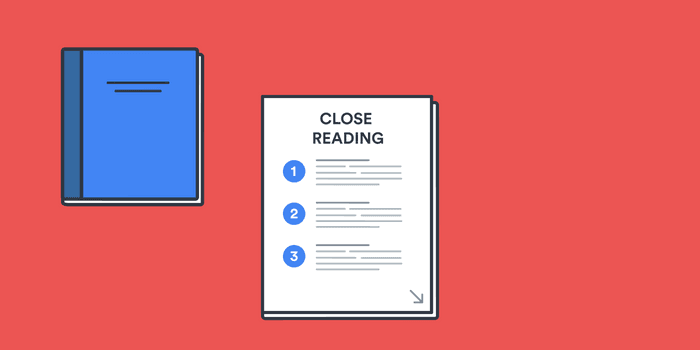
Close reading refers to the process of interpreting a literary work’s meaning by analyzing both its form and content. In this post, we provide you with strategies for close reading that you can apply to your next assignment or analysis.
What is a close reading?
Close reading involves paying attention to a literary work’s language, style, and overall meaning. It includes looking for patterns, repetitions, oddities, and other significant features of a text. Your goal should be to reveal subtleties and complexities beyond an initial reading.
The primary difference between simply reading a work and doing a close reading is that, in the latter, you approach the text as a kind of detective.
When you’re doing a close reading, a literary work becomes a puzzle. And, as a reader, your job is to pull all the pieces together—both what the text says and how it says it.
How do you do a close reading?
Typically, a close reading focuses on a small passage or section of a literary work. Although you should always consider how the selection you’re analyzing fits into the work as a whole, it’s generally not necessary to include lengthy summaries or overviews in a close reading.
There are several aspects of the text to consider in a close reading:
- Literal Content: Even though a close reading should go beyond an analysis of a text’s literal content, every reading should start there. You need to have a firm grasp of the foundational content of a passage before you can analyze it closely. Use the common journalistic questions (Who? What? When? Where? Why?) to establish the basics like plot, character, and setting.
- Tone: What is the tone of the passage you’re examining? How does the tone influence the entire passage? Is it serious, comic, ironic, or something else?
- Characterization: What do you learn about specific characters from the passage? Who is the narrator or speaker? Watch out for language that reveals the motives and feelings of particular characters.
- Structure: What kind of structure does the work utilize? If it’s a poem, is it written in free or blank verse? If you’re working with a novel, does the structure deviate from certain conventions, like straightforward plot or realism? Does the form contribute to the overall meaning?
- Figurative Language: Examine the passage carefully for similes, metaphors, and other types of figurative language. Are there repetitions of certain figures or patterns of opposition? Do certain words or phrases stand in for larger issues?
- Diction: Diction means word choice. You should look up any words that you don’t know in a dictionary and pay attention to the meanings and etymology of words. Never assume that you know a word’s meaning at first glance. Why might the author choose certain words over others?
- Style and Sound: Pay attention to the work’s style. Does the text utilize parallelism? Are there any instances of alliteration or other types of poetic sound? How do these stylistic features contribute to the passage’s overall meaning?
- Context: Consider how the passage you’re reading fits into the work as a whole. Also, does the text refer to historical or cultural information from the world outside of the text? Does the text reference other literary works?
Once you’ve considered the above features of the passage, reflect on its relationship to the work’s larger themes, ideas, and actions. In the end, a close reading allows you to expand your understanding of a text.
Close reading example
Let’s take a look at how this technique works by examining two stanzas from Lorine Niedecker’s poem, “ I rose from marsh mud ”:
I rose from marsh mud, algae, equisetum, willows, sweet green, noisy birds and frogs to see her wed in the rich rich silence of the church, the little white slave-girl in her diamond fronds.
First, we need to consider the stanzas’ literal content. In this case, the poem is about attending a wedding. Next, we should take note of the poem’s form: four-line stanzas, written in free verse.
From there, we need to look more closely at individual words and phrases. For instance, the first stanza discusses how the speaker “rose from marsh mud” and then lists items like “algae, equisetum, willows” and “sweet green,” all of which are plants. Could the speaker have been gardening before attending the wedding?
Now, juxtapose the first stanza with the second: the speaker leaves the natural world of mud and greenness for the “rich/ rich silence of the church.” Note the repetition of the word, “rich,” and how the poem goes on to describe the “little white slave-girl/ in her diamond fronds,” the necessarily “rich” jewelry that the bride wears at her wedding.
Niedecker’s description of the diamond jewelry as “fronds” refers back to the natural world of plants that the speaker left behind. Note also the similarities in sound between the “frogs” of the first stanza and the “fronds” of the second.
We might conclude from a comparison of the two stanzas that, while the “marsh mud” might be full of “noisy/ birds and frogs,” it’s a far better place to be than the “rich/rich silence of the church.”
Ultimately, even a short close reading of Niedecker’s poem reveals layers of meaning that enhance our understanding of the work’s overall message.
How to write a close reading essay
Getting started.
Before you can write your close reading essay, you need to read the text that you plan to examine at least twice (but often more than that). Follow the above guidelines to break down your close reading into multiple parts.
Once you’ve read the text closely and made notes, you can then create a short outline for your essay. Determine how you want to approach to structure of your essay and keep in mind any specific requirements that your instructor may have for the assignment.
Structure and organization
Some close reading essays will simply analyze the text’s form and content without making a specific argument about the text. Other times, your instructor might want you to use a close reading to support an argument. In these cases, you’ll need to include a thesis statement in the introduction to your close reading essay.
You’ll organize your essay using the standard essay format. This includes an introduction, body paragraphs, and a conclusion. Most of your close reading will be in the body paragraphs.
Formatting and length
The formatting of your close reading essay will depend on what type of citation style that your assignment requires. If you’re writing a close reading for a composition or literature class , you’ll most likely use MLA or Chicago style.
The length of your essay will vary depending on your assignment guidelines and the length and complexity of the text that you’re analyzing. If your close reading is part of a longer paper, then it may only take up a few paragraphs.
Citations and bibliography
Since you will be quoting directly from the text in your close reading essay, you will need to have in-text, parenthetical citations for each quote. You will also need to include a full bibliographic reference for the text you’re analyzing in a bibliography or works cited page.
To save time, use a credible citation generator like BibGuru to create your in-text and bibliographic citations. You can also use our citation guides on MLA and Chicago to determine what you need to include in your citations.
Frequently Asked Questions about how to do a close reading
A successful close reading pays attention to both the form and content of a literary work. This includes: literal content, tone, characterization, structure, figurative language, diction, sound, style, and context.
A close reading essay is a paper that analyzes a text or a portion of a text. It considers both the form and content of the text. The specific format of your close reading essay will depend on your assignment guidelines.
Skimming and close reading are opposite approaches. Skimming involves scanning a text superficially in order to glean the most important points, while close reading means analyzing the details of a text’s language, style, and overall form.
You might begin a close reading by providing some context about the passage’s significance to the work as a whole. You could also briefly summarize the literal content of the section that you’re examining.
The length of your essay will vary depending on your assignment guidelines and the length and complexity of the text that you’re analyzing.
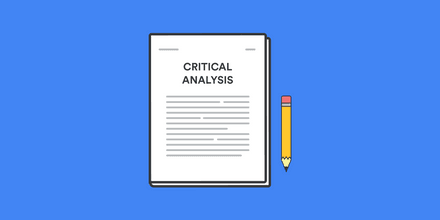
Make your life easier with our productivity and writing resources.
For students and teachers.
Purdue Online Writing Lab Purdue OWL® College of Liberal Arts
Close Reading a Text and Avoiding Pitfalls

Welcome to the Purdue OWL
This page is brought to you by the OWL at Purdue University. When printing this page, you must include the entire legal notice.
Copyright ©1995-2018 by The Writing Lab & The OWL at Purdue and Purdue University. All rights reserved. This material may not be published, reproduced, broadcast, rewritten, or redistributed without permission. Use of this site constitutes acceptance of our terms and conditions of fair use.
Also see the OWL handout on Writing about Literature and the OWL handout on Literary Terms .
Writing about a story or novel can be difficult because fiction is generally very complex and usually includes several points or themes. To discover these interwoven meanings, you must read the work closely. Below are three techniques for reading fiction actively and critically. Close reading takes more time than quick, superficial reading, but doing a close reading will save you from a lot of frustration and anxiety when you begin to develop your thesis.
Close Reading a Text
Use these "tracking" methods to yield a richer understanding of the text and lay a solid ground work for your thesis.
Pitfalls: Highlighting too much Highlighting without notes in the margins
These should be questions, comments, dialogue with the text itself.
A paragraph from Doris Lessing's short story "A Woman on a Roof" serves as an example:
The second paragraph could have a note from the reader like this:
Write quickly after your reading: ask questions, attempt answers and make comments about whatever catches your attention. A good question to begin with when writing response entries is "What point does the author seem to be making?"
After close reading and annotating, can you now make a statement about the story's meaning? Is the author commenting on a certain type of person or situation? What is that comment?
Avoiding Pitfalls
These four common assumptions about writing about fiction interfere with rather than help the writer. Learn to avoid them.
Assumes that the main task is simply recalling what happened in detail. Plot summary is just one of the requirements of writing about fiction, not the intended goal.
Assumes that writing about fiction is a "no win" game in which the student writer is forced to try to guess the RIGHT ANSWER that only the professor knows.
Assumes that ANY interpretation of any literary piece is purely whimsy or personal taste. It ignores the necessity of testing each part of an interpretation against the whole text, as well as the need to validate each idea by reference to specifics from the text or quotations and discussion from the text.
Assumes that writing the paper is only a way of stating the answer rather than an opportunity to explore an idea or explain what your own ideas are and why you have them. This sometimes leads to "padding," repeating the same idea in different words or worse, indiscriminate "expert" quoting: using too many quotes or quotes that are too long with little or no discussion.

Write a Close Reading
Choose a passage, step 1: read the passage, step 2: analyze the passage, step 3: develop a descriptive thesis, step 4: construct an argument about the passage., step 5: develop an outline based on your thesis.
- Tips for Close Readings
- Close Reading in English Literature
- Close Reading in Philosophy
Ask Us: Chat, Email, Visit or Call

More Help: Writing
- Book Writing Appointments Get help on your writing assignments.
If you have not been assigned a passage or poem, then you must select a text and a specific passage.
Limit your selection to a paragraph or two at the most. In some cases, a sentence or two (or a few lines, if you are dealing with a poem) will be sufficient. Keep in mind that literature (and especially poetry) can be very dense. You will be surprised at how much you can glean from a short section – and how easily you can be overwhelmed by selecting a section that is too long.
Look for unusual or repetitive images or themes and passages with rich imagery or language.
Also pay particular attention to passages that relate to central characters or definitions of keywords; you may decide to focus on one section and how it helps you understand a character, relationship, issue, or idea.
Take notes as you read. Mark anything that seems relevant or interesting to you – even if you are unsure why a particular section of the text stands out.
Ask yourself: How is language and/or argument being used? Take notes about your observations of the passage, even if these observations seem simplistic or self-evident. Also pay attention to how language use changes over the course of your passage. For example, if the same word appears at the beginning and end, does it mean different things in both places? Does the author's tone or attitude change?
After you have read the entire text, you can return to these sections to look for repeated patterns, themes, or words. Often, a close reading will focus on one example of a theme or pattern to study the significance of this theme or pattern more in depth.
Begin by writing answers to some of the following questions, focusing on the kinds of rhetorical and literary devices you see in the passage.
- What words are being used here?
- Are any words repeated in this passage?
- What adjectives are used? What nouns do they describe? How do they alter your understanding of these nouns?
- Are any two (or more) words used in this passage connected in some way?
If any words are unfamiliar, look them up. If you are analyzing an older text, keep in mind that words may mean different things at different points in history—so be sure to look up any words that may be familiar but used in an unfamiliar way. The Oxford English Dictionary (OED) will provide you with definitions as well as histories of word use.
Whether you are looking at an historical or contemporary text, remember that words can be used in different ways. Ask yourself: Are any words being used in unusual ways? Are any words referring to something more than what is simply stated? Are any two (or more) words in the passage connected in some way?
Narrative Voice
- Who is speaking in this passage?
- What narrative perspective is being used in this passage?
- What does the narrative voice tell you?
- What characters does it give you access to?
- Is the speaker being straightforward, factual, open?
- Is the speaker being direct or ambiguous with their message?
- Does the voice carry any emotion? Or is it detached from its subject?
- Do you hear irony (what is said is different from what is meant)? If so, where?
Rhetorical and Literary devices:
- Do you notice any figurative language, such as metaphors and similes?
- Do you observe any imagery?
- Is the sound of the language and sentences important (e.g., rhyme, repetition, choppy or long sentences)?
- What is the effect of these devices and techniques? (e.g., do they add emphasis or connect key ideas?)
Once you have finished looking at the language in detail, you can use your observations to construct a descriptive thesis. For example, you could argue that a passage is using short, simple sentences, or that it is using irony or a combination of these things. Your descriptive thesis should attempt to summarize the observations you have made about HOW language is being used in your passage.
Remember, this is not your final thesis statement. It's just your first step to arriving at an analytical thesis.
Now that you have some idea of HOW language is being used in your passage, you need to connect this to the larger themes of the text. In other words, you now need to address WHY language is being used in the way (or ways) you have observed.
This step is essential to a successful close reading. It is not enough to simply make observations about language use – you must take these observations and use them to construct an argument about the passage.
Transform your descriptive thesis into an argument by asking yourself WHY language is used in this way:
- What kinds of words are used (intellectual, elaborate, plain, or vulgar)? Why are words being used in this way?
- Why are sentences long or short? Why might the author be using complicated or simple sentences? What might this type of sentence structure suggest about what the passage is trying to convey?
- Who is the narrator? What is the narrative voice providing these particular descriptions? Why are we given access to the consciousness of these particular characters? Why not others?
- What images do you see in the passage? What might they represent? Is there a common theme?
- Why might the tone of the passage be emotional (or detached)?
- To what purpose might the text employ irony?
- What effect/impact is the author trying to create?
After you have established your thesis, you’ll need to write an essay that supports this argument with examples and analysis.
For example, you might argue that in the novel Jane Eyre , Jane’s friend Helen Burns uses language and imagery to describe God in a very different way from characters who represent religious authority. To prove your argument, you must organize your essay to show examples of how Helen Burns describes God and interpret her description. You must also analyze how her description differs from the status quo in the novel and tell readers why this difference matters to our understanding of the novel.
- << Previous: Start Here
- Next: Tips for Close Readings >>
- Last Updated: Oct 2, 2023 1:29 PM
- URL: https://guides.lib.uoguelph.ca/CloseReading
Suggest an edit to this guide
This work is licensed under a Creative Commons Attribution-NonCommercial-ShareAlike 4.0 International License.
Close Reading of Literary Texts
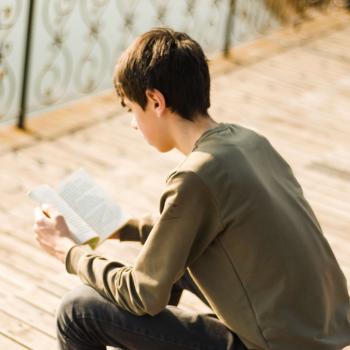
About this Strategy Guide
This strategy guide will help you choose text that is appropriate for close reading and to plan for instruction that supports students' development of the habits associated with careful, multi-engagement reading of literary prose and poetry.
Research Basis
Strategy in practice, related resources.
Fisher & Frey (2012) remind us that “the practice of close reading is not a new one, and in fact has existed for many decades as the practice of reading a text for a level of detail not used in everyday reading” (p. 8). Buckley (2011) explains that “as English teachers, we have to empower all our students to use texts to construct and represent meaning skillfully, because by every measure, it gives them a better chance at having a better life” (p. 3). She goes on to say that “all students deserve a chance to learn how to demonstrate their ambitious exploration of text” (p. 29), a notion supported by Fisher & Frey (2012) when they remind us that “close reading should be accompanied by purposeful, scaffolded instruction about the passage” (p. 8).
- Selecting a text:
When selecting a text or passage for close reading, consider two questions: First, is there enough going on with the language and craft of the text to warrant the attention of multiple readings? Second, does the understanding that comes from close reading sufficiently benefit students in light of the larger goals of the course or unit? The answer to both needs to be yes in order to keep close reading from falling into its reputation as merely an exercise.
- First, to determine the general meaning of the text (leaving knowledge and application of literary elements more or less tacit for now). Keep asking yourself, “What’s going on, and how do I know?”
- Second, to examine the ways the author uses language and the discipline-specific structures of literature to create meaning. Your focusing question here might be “How do the author’s choices help me understand or appreciate something that I didn’t notice the first time I read?”
- Third, to consider thematic meaning and connections between this text and others like it. Here, ask yourself, “What does this text cause me to think or wonder about some larger aspect the text and of the human condition?”
These purposes are certainly not exclusive of each other, and do not necessarily happen in the order listed here, but having these multiple purposes helps students see the value in re-reading text they might otherwise work quickly through just once to “get the gist.” See the Close Reading Planning Sheet for a printable guide to this process.
This process is not unlike preparing for a think-aloud, only here, you work is not to plan what you will say about your understanding of the text as you read, but rather to think of the places where you want to prompt students’ thinking with questions that cause them to consider the text carefully.
- Developing text-dependent questions and accompanying learning activities:
You can see the Sample Close Reading Questions that resulted of my multiple readings of the first section of the short story “The Gift of the Magi” by O. Henry and the poem “Latin Deli” by Judith Ortiz Cofer. The questions are listed here for clarity as first read, second read, third read to show how the focus of questioning might change over multiple readings. You would decide, of course, how the questions were actually asked with each reading, how much time should pass between readings, and so forth.
Remember that close reading should be embedded in an instructional context that values not only the careful attention to text that the questions prompt, but also writing, collaboration, and talk. The specific ways in which you balance these elements will vary, but the scaffolding provided by the text-dependent questions you prepared will likely connect them all.
More Ideas to Try
- If the deep understanding they develop through the process does not extend into meaningful talk or writing, students will see close reading questions as an end themselves, rather than a means. See the Writing Arguments about Literature Strategy Guide for ideas on framing close reading around a larger writing task.
- Providing students with close reading questions is a scaffold to the actual task of reading and re-reading carefully. After they use questions you’ve prepared, have students dissect the kinds of thinking each reading represented. Use this discussion to prompt them to develop multiple sets of close reading questions for a text.
- Lesson Plans
- Professional Library
- Strategy Guides
Students develop close reading skills connecting sound with sense in the poem "Those Winter Sundays," and write an original text that reflects their new learning.
Using their voices as interpretive instruments, students gain a deeper appreciation of the art of poetry as they prepare a recitation of the frequently anthologized poem "Those Winter Sundays."
Students often find poetry frustrating and meaningless. By helping students think critically about the differences between poetry and prose, this introduction sets the stage for different strategies for comprehending poetic texts.
Using several translations of the same passage of Beowulf , this lesson introduces students to the idea that translation is not an objective practice, but that it involves "imaginative reconstruction."
- Print this resource
Explore Resources by Grade
- Kindergarten K
Assignments
Assignment: close reading.
A close reading is a study of the detail in a short section of a text and an explanation of how that detail and that section are related to the entire text. In thinking about literature, you should always refer back to the detail of a text as well as to its grander effects. The project requires critical thinking and concise writing.
Prewriting Process
- Re-read or re-watch one of the readings and/or films we have studied so far this semester, taking notes while reading or viewing. Look for patterns, tensions, or questions that emerged in what you noticed.
- Choose a short passage that you can focus on. (Write out the transcript if using a video.) The passage should be a key section of the work, and should contain concrete imagery. Consider whether this passage reinforces, adds a new dimension, or subverts the themes as worked out in other parts of the work? How? Why? How does this section help you to understand the entire piece?
- Consider how the concrete imagery in the section is working. Does the image work as a symbol in some way? Does it affect your emotions or intellect or understanding of the story?
- Carefully comb through all the words, using the margins to record your thoughts. Note the figures of speech. Look at word choice. Pay attention to the details.
- Decide on a thesis, create a structure for your paper that will support that thesis, and then use evidence from the text to support your main points. (This becomes your outline.)
Writing Process
- Quote the passage (or transcript) directly, set off at the top of the page like an epigraph.
- Create a title that captures the heart of your thesis.
- Briefly summarize the passage.
- Place this section within the context of the whole text. Why is it significant to the plot, character development, or other concerns? If it is comic relief, say so. Does it recapitulate, perhaps, in a “miniature,” the major plot? Or does it perhaps indicate a counter-movement, an uneasiness, even contradicting major themes?
- In separate paragraphs, discuss your most interesting discoveries in the areas of themes, details, vocabulary, language/style, structure, progress/movement, and metaphors. Outline the interesting ideas you have discovered, quoting the significant relevant lines—even quoting lines outside your passage if you need to make connections. You should always be moving toward revealing why that particular “evidence” points toward a specific judgment about the text as a whole. Continually ask: Is my passage reinforcing, adding a new dimension to, or subverting what I know in general (from lecture and class discussion) about the text?
- Conclusion? A “close reading” usually ends with a paragraph that opens up and points towards even grander potential meanings for the passage. (In other words, don’t just repeat everything you said.)
- 600–800 words
- no outside sources (Works Cited page still needed for the work you are analyzing)
- Close Reading. Authored by : Heather Gemmen Wilson. Provided by : Ivy Tech Community College. License : CC BY: Attribution

Close Reading Strategies That Work: 5 Ways to Teach Close Reading in Secondary ELA
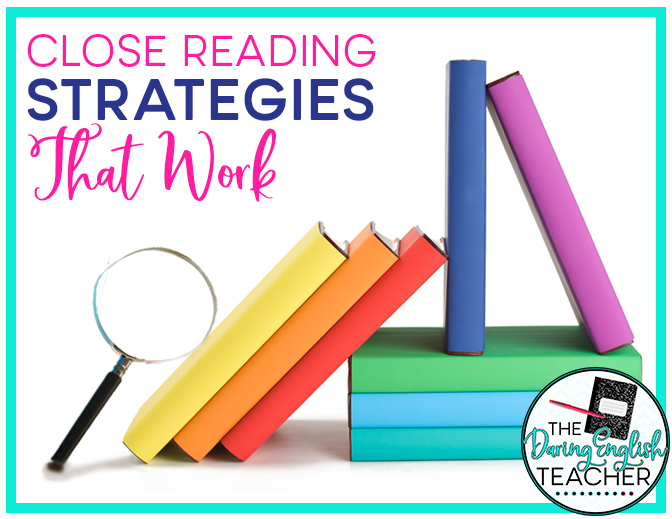
Close reading is an integral and essential component of the common core standards. Close reading asks students to not only read a text for basic comprehension and understanding, but to really read the text, dig deeply into the text, and make connections with the text. Here is a look at close reading strategies that are effective and engaging in the middle school ELA and high school English classroom.
This can be a difficult and daunting task for a generation that grew up bubbling a scantron and moving on to the next task.
Close Reading Strategies: 1 – Don’t rush them.
When my students closely read a text, I make sure to not rush them. We as educators have to keep in mind that this is their first exposure to the text. We can’t take for granted that they will understand every word, metaphor, and rhetorical device in the text. Close reading is a process that takes time, patience, and multiple readings. There is no such thing as reading a sentence, a paragraph, or a composition too many times. To begin the close reading process, I like to teach my students how to annotate text.
My Annotation Bookmarks will help keep students focused when they are annotating. Sometimes students just need some time and a guideline to get used to annotating.
Close Reading Strategies 2 – Focus on a new concept for each reading.
Even the brightest and most advanced students will be overwhelmed when they are given too many concepts and/or rhetorical devices to look for and analyze in one reading. Sure, they may complete the task, but it won’t be at the depth in which they are capable. Instead, just work on one close reading focus at a time. Not only will this help students be more engaged with the text and really understand the concept, but they will also build a better understanding of the text because they will have more exposure to it.
If you are focusing on analyzing a piece of nonfiction for rhetorical devices, just focus on one at a time and start with the easier to understand rhetorical devices. This strategy will allow students to gain a better understanding of the text, which will then allow them to closely read the text for more difficult concepts. When I closely read short stories with my students, I use focused sticky note graphic organizers that help students identify key literary elements.
I rely on short story close reading assignments to help me guide my students through this step of the process. These units focus on just one literary element at a time. For example, if we are reading a short story, we might focus on just identifying suspense first. Then, after students are able to identify, quote, and explain examples of suspense, we will move to a new literary focus. This really provides students the opportunity to understand the text and the literary elements we are focusing one.
Short Story Close Reading Bundle
Close Reading Strategies: 3 – Don’t forget about vocabulary.
Whenever we do a close reading in my classroom, I am always amazed at the words students do not know. Even if a word seems like an easy, common word, we cannot simply assume that our students are familiar with it. For this reason, I do not like assigning vocabulary lists when I do close readings. Instead, I prefer to rely on my students and their existing vocabulary. One of our close reading focuses is just on vocabulary. I have the students box any words with which they are unfamiliar, and then write the definitions in the margins.
Taking time to do a vocabulary close read is essential. Students gain such a better understanding of the material once they become familiar with the unknown words. To make this activity even more meaningful, I like to have them partner up after completing an individual vocabulary close read. Many times students will overlook words they do not know. Providing them with an opportunity to partner up for a second vocabulary close read really enforces this activity. I urge the students to not copy each other’s work. Instead, they are to read the definitions to their partners. Once this is complete, the student read a document, identified unfamiliar words, defined these words, wrote down the definitions, and spoke the definitional aloud. All of these different interactions with the once unfamiliar words really provides the students with an opportunity to genuinely learn new words.
Close Reading Strategies: 4 – Place an emphasis on collaborative learning.
Close reading is not and should not be an individual effort. Every single student brings a unique perspective to the table, and we should embrace these unique perspectives. When we do close readings in my classroom, I like to have the students read individually, but I also like them to partner up, work in small groups, work in larger groups, and then start the process all over again, but this time with new partners and new groups.
One way to incorporate group work into close reading is to assign each group a specific task. For example, if your students are analyzing figurative language within a text, you can assign each group a specific type of figurative language. After a set amount of time, have the students either share their finding aloud and on the board or through a document reader. Similarly, you can also have the students change groups and share their findings with other students. This type of collaborative activity generates excellent classroom discussion.
Close Reading Strategies: 5 – Give the students time to work.
One of the most vital aspects of teaching close reading is providing students with the opportunity to complete the task. Once you teach the student how to closely read and annotate a text, you will need to model the skill using a small portion of the text. After that, you will need to step back and be a facilitator. You will spend the majority of your instructional time fielding questions and witnessing authentic learning at its best.
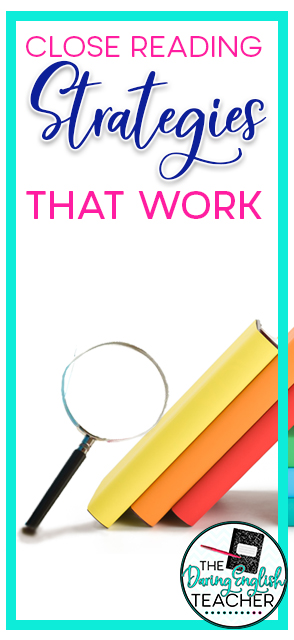
You have inspired me. I love the collaborative idea to close reading. I will try this strategy next week as the new quarter starts. Thank you.
You are welcome. I hope you enjoy incorporating these strategies into your classroom!
Leave a Reply Cancel reply
Your email address will not be published. Required fields are marked *
Save my name, email, and website in this browser for the next time I comment.

SUBSCRIBE NOW

Close Reading Activities to Try (22 Examples & a Download)

What is Close Reading?
When a student engages in a close read they are doing the opposite of skimming. Close reading entails really delving into the document, usually reading it several times in order to gain a deeper understanding each time. Oftentimes each reading will have students looking for a different aspect of the content, from a casual summary to identifying the voice and point of view of the author.
Many students don’t want to read a document even one time; how are you supposed to get them to read it several times?! With imagination, ingenuity and trickery — yup, gotta do whatever it takes! Make it look fun and they’ll never know they’re reading a passage again and again.
Oftentimes I include 2-4 short activities into 1 lesson. This helps to reach more students in various ways. It also helps with kiddos who have a short attention span.
Below are 22 activities to try:
1. choice boards.
This is the newest title given to a method of instruction that allows students various options to reflect their understanding of a topic. Back in the day it was called a menu.

Students are given a “menu” of activities and questions. The appetizer is usually a short warm-up question. They choose from the menu and complete one.
The entree is the “meat” of the lesson and offers more than one activity to reflect understanding. One choice might be to create a storyboard while another is to make a political cartoon, a third could be a writing assignment.
Finally, the dessert is the exit question for the lesson.
Another style of choice board that I use ALL the time is Tic-Tac-Toe. Your kiddos simply choose any three activities in a row to complete.
Here is a generic version that you can download. It works with almost any reading passage that you assign in social studies.


2. Annotation

- Try giving out colored pencils, 1 color is for all the causes, another for effects. This allows you to assess if a student is having difficulty identifying one or the other (causes or effects). Also, it adds a bit of an art element to the exercise, which many students enjoy.
- OR students are asked to UNDERLINE the CAUSES and DOUBLE-UNDERLINE the EFFECTS.

- The group would then come together to share and peer assess the thoroughness and validity of each group member’s findings.
- Finally, students can write the overall findings in their notebooks.
3. Finding Evidence

This is a great way to “force” students to really read deeply. As with annotation, there are several ways to accomplish this method. Students are given text-dependent questions that they answer using evidence from the reading.
- In groups each student answers one of four questions you formulated on separate sheets of paper and provides one piece of evidence. Everyone then passes to the right and the next student must find another piece of evidence. This continues until each group member has provided evidence for each of the questions.
- The questions can be scaffolded by increasing the level of rigor. Groups can work together, with each being responsible for a few of the questions, then sharing out. You can create homogeneous groups and assign the more challenging questions to the higher level group. Include one question that is a level 3 on the DOK chart for all groups to grapple with.
- One way to differentiate this lesson is to offer ten statements and allow students to choose any seven or eight to prove or disprove using evidence from the document.
CHECK OUT MY GUIDE FOR IMPROVING ACCOUNTABLE TALK HERE!
4. Students Create Questions

Asking students to create questions is always a rigorous task for them. Here are a few ways to implement this method:
- Students work in pairs creating several (3-5) high level questions. I nclude guidelines such as: no yes or no questions,no when or where questions. Model some question starters to get them rolling; how, why, what if, are a few that should generate higher level questions. You can collect them and distribute for other pairs to try and answer.

- Groups can create multiple choice questions. This is MUCH harder than it seems and is a good challenge.
- One of my colleagues has groups of four students create four rigorous questions and then the class plays “Battleship” . The first group “bombs” another group by throwing one of their questions to another group in a paper ball. If the group answers they then get to bomb another group. If they cannot answer in a prescribed time their battleship is sunk. Depending on time allotment each group can have two or three battleships to sink before they’re out of the game.
5. Mind Mirror

For a creative, artistic approach to close reading students can create mind mirrors. This works well with readings about people (leaders, philosophers, etc) as well as economic and political theories (communist, capitalism, absolute monarchy, etc.)
- First students read and annotate for any ideas, beliefs and actions in the content.
- Individually or in pairs supply a large sheet of paper for them to draw a head (it doesn’t have to been human)
- Students then draw symbols, quotes, pictures, and beliefs on the head instead of eyes, nose and ears.
- Decide, based on your students and the reading, a minimum number of symbols and pictures that should be included.
- To share-out post the mind mirrors around the room and 1 half of the pair stay with the work to describe it and answer any questions. Halfway through the gallery walk the pairs switch places and the 2nd half of the pair stays with their work while the other travels around the room.
6. True or False
Give students a series of facts and quotes. They have to identify which are true and false based on their reading.

7. This or that
This is similar to true or false with a twist. Your kiddos are faced with 2 facts and have to decide “this or that”

8. Design bumper sticker/ tee shirt
This activity is great for your artistic and creative kids. Have them design (like the heading says) a bumper sticker or tee shirt with an appropriate slogan for the content. For the presidency of Donald Trump I — of course — had them design a hat:) This is harder than it looks. Siphoning an idea down to a few words is more difficult than writing a paragraph about it.
9. Connect 4
I like to gamify activities whenever possible. Adding a little fun never hurt anyone! If you’re familiar with the game Connect 4, it’s just like tic-tac-toe only it’s 4 in a row.

10. Guided notes
This is an old-school method of notetaking but scaffolds the assignment by adding guidance. Create a graphic organizer with topics for students to cull from the reading and write down.

11. Complete the sentence
Sentence starters are a great way to support struggling students and it also encourages close reading. (See picture above)
12. Gameboard
Did I mention that I like to gamify assignments whenever possible? Probably like 10 times, because it’s true! Making a simple game board takes a question and answer assignment to a whole other level!

13. Put in order
Give students a list of events and ask them to put it in order. This will necessitate their going back to the reading again and again.

14. Making Connections
Describe how each person impacted the main character in your lesson asks them to read closely to find the information, but also to extrapolate the connection between the characters.

15. Use pictures
Incorporating pictures into an assignment makes it seem SUPER easy; but it doesn’t have to be. Here is an example of an activity that requires analysis but is user friendly.

16. Timeline
The good ole timeline; who doesn’t love a timeline? There is NO WAY a kid can create one of these without close reading!

17. Compare/contrast
Ahem, ever heard of a Venn diagram? Yes, comparing and contrasting definitely requires close reading.

18. Check for understanding of important terminology
An important part of reading comrehension is underting new vocabulary. To ensure students are “getting it” you can check for understanding using probing questions that require a deep understanding of the term.

19. Elimination
Give students a list of causes, effects, technology and ask them to identify which are referrable to the content of their reading passage.

20. Word scramble
Word puzzles are fun for many students. It feels like a game rather than close reading. You can throw in 1 or 2 at the end of a worksheet or make it more complex.
Another type of word game is word search. I have TONS of word search puzzles for U.S. and world history that you can download right on this site.

21. Formulate opinions with evidence
I’m sure you frequently ask your kiddos to give their opinions on topics. If they are expected to back up their opinions with evidence from a particular reading they will have to interact with the material several times, which is the whole point, right?
Asking them to identify both their point of view and also the contrarian view is a rigorous exercise for most students.

22. Fill in the blank
Finally, fill in the blank is another option. Normally I’m not a proponent of “slot notes”. I feel like they’re very low on the DOK scale. However, in order to help struggling students they have their place.
This example offers a word bank and a bit of gamification. You could differentiate and offer only your Ells and SWDs the word bank and not your gen ed kiddos in order to challenge them.

23. (Bonus) Four Corner Debates
I don’t know if you’ve tried debating in your class. There are many styles you can implement. I find a lot of them too loosy-goosy for my students. One that gets literally everybody up and participating AND encourages close reading is a 4 corner debate.
The short story is that students are given controversial statements and must choose if they strongly agree, agree, disagree or strongly disagree. They write down evidence to support the opinion (this is where the close reading comes in).
Once everyone’s chosen their point of view they go to whichever corner of the room is labeled with their opinion: strongly agree, agree, disagree or strongly disagree (hence 4 corners). I have a whole post on this debate format you can check out.
The benefits of close reading are self-evident. A student that reads deeply and analyzes the text in numerous ways will come away with a much better understanding of the content.
Getting reticent readers to engage in a close read can be a challenge. You may want to start with a highly engaging article, even if it is not infused with as much content as you would like, as a way to incite interest and allow students to gain the skills necessary for a successful close read.
By employing various methods throughout the semester you will reach more students and keep the class fresh. You will also learn which of the methods resonates with your students.
Reading is the most critical skill for any person of any age. Everything else emanates from the ability to comprehend, synthesize and analyze the written word. If we can move students forward one tiny step at a time wonderful results can be achieved over the course of a school year.

I hope some of these ideas resonate with you. Please reach out with any questions, reactions or requests for future articles at [email protected].
Teach and Thrive
A Bronx, NY veteran high school social studies teacher who has learned most of what she has learned through trial and error and error and error.... and wants to save others that pain.
Recent Posts
Chronicles of Iceland: A Colorful Glimpse into a Thousand-Year Legacy
Iceland had a colorful history ever since the first settlers came from Northern Europe in the 9th Century. Erik the Red, exiled for murder, settled in Greenland. Other Viking explorers reached the...
Principles of Historical Analysis: Change and Continuity
Historians use “continuity and change” to refer to aspects of life or society that have remained the same (continuity) or developed over time (change). History is not merely about dates, events,...

Three Quick and Easy Close Reading Exercises to Use Every Day
- July 27, 2022
- AP Literature , Close Reading , English 11
I have recently been reading a professional development book that suggests that high school English teachers are sending their students off to college unprepared for the amount, frequency and difficulty of college reading. While our students will often skate on the reading outside of class, we can spend time in class using close reading exercises that will help them at least discern what it is important in that reading.
What is Close Reading?
Close reading simply put is rereading. Close reading results in a deeper understanding of the text. It is the idea that you read a text once for meaning and additional times to analyze it. Reading a second, third or even fourth time allows students to pick up on the other important aspects of the text.
In literature courses, close reading will focus on meaning followed by analysis of author’s craft. And the best strategies for close reading with high school students is daily practice. Because close reading involves rereading not just once, but multiple times, it is important that students do not try to close read entire texts. (Unless they are really short like flash fiction. For more, read about Flash Fiction Bootcamp .)
Close reading should focus on shorter passages. Passages that are under 800 words work best, but even shorter passages can be truly advantageous in teaching high school students how to do close reading.

Three Close Reading Exercises to Use Every Day
The easiest way to insure that students are practicing the steps to close reading everyday is to provide them with daily opportunities to practice.
Use Warm Ups for Close Reading Exercises
My favorite way for students to do daily practice of close reading is through warm ups or bell ringer activities. (For more on how to use bell ringers in high school English class, check out this post .)
We use the same poem or passage each day for a whole week . As a result, in these close reading exercises, students are almost forced to reread because it will have been 24 hours since we last discussed the text. Since these passages are not intended to be the focus of class times, they should be very short. The target length for poems is under 25 lines and the target for prose passages is 250 words (give or take 50).
For more on using Poem of the Week, check out Teaching Poem Analysis through Poem of the Week .

Use Targeted Passages from Longer Texts
When your class is working on a longer text, it is really important that you take time to target passages for close reading exercises. If you were to try to close read an entire text (like Hamlet , for example) you would setting your students up to write their dissertations. They are simply not ready for that level of reading. Therefore, it is your job as the teacher to decide which passages to focus on.
Because these passages can be the focus of a whole class lesson, they can be a little longer. But you will still want to choose passages for close reading exercises that are between 500-800 words. Anything longer will bog down the process. (Trust me on this one.)
There are several ways to decide what to target for close reading of longer texts.
Close Reading: How to Choose Passages
- Choose passages to focus on character development: choose 3-5 passages that help to establish how the character changes over the course of the text. This works great with novels and short stories. An easy way to do this with a play by Shakespeare is to focus on the soliloquies.
- Pick passages to help students see the themes. One of the last steps for close reading is to identify the theme. However, you can help students see how an author develops the theme of a text by selecting passages that focus on the same topic or abstract idea so at the end, they can pull them together to write a theme statement.
- Choose passages to teach students to use the lenses of literary criticism . Teaching students to use the lenses of literary criticism (like psychological, archetypal, historical) can be challenging. If you select passages to target specific lens, it is easier for students to focus. Again, Hamlet comes to mind. Use those soliloquies to focus in on Hamlet’s mental state. Or use dialogues between Hamlet and Ophelia. Use Lady Macbeth to help students do a feminist reading (Enter Lady Macbeth Close Reading ).
The great thing about pulling passages from a longer text is that is unnecessary for every student to read every passage. You can use groups to jigsaw or present to entire class.
Have Students Pick their own Close Reading Passages
I began this post by discussing the fact that students are heading to college unprepared for (close) reading at a college level. So it is important that we work toward letting students select their own passages for close reading.
Once you have given them opportunities to see how you choose passages, you can let them choose their own. You can use the same guidelines for selecting a passage. Have them choose passages to show character development, related to an overarching topic (this will help them to determine them on their own) or using a lens.
These are great activities to do when students are working in book clubs. In my Reading Like a Professor Book Clubs , students use choice boards to select passages for double entry journals based on the lessons from Thomas Foster’s book How to Read Literature Like a Professor .
Additionally, you could have students select passages to lead discussion (for more on this, check out this post ) or to write double entry journals ( for more on this, check out this post ).

Why these Close Reading Exercises Work
Close reading works because it allows students to focus their attention. These strategies for close reading work because they are varied and allow for daily practice. And as I always tell my students (and my own children), the only way to get better at anything is through practice and using these close reading exercises are just the ticket..
Related Resources
Need Bell Work ideas for English? The Great Bell Ringer List for High School English
Get all the details about Teaching Poem Analysis through Poem of the Week .
Close Reading for Poetry: 4 Simple Solutions to Teach Poetry Analysis
Give them steps they can use every time: 5 Strategies for Better Close Reading
Try two column responses: 11 Brilliant Strategies for Dialectic Journals to Better Close Reading
Shop This Post
Use Poetry for Close Reading Warm Up: Daily Poetry Close Reading Exercises
Get them doing their own close reading: Reading Like a Professor Book Clubs
Try using the schools of Literary Criticism Anchor Chart Bundle
more from the blog

The AP English Exam is Over–What’s Next?
It’s almost May, which means those of us who teach AP® English are wrapping up in preparation for the exams. It doesn’t matter whether that

Bell Ringer Ideas for High School English
The moment our students walk in the classroom, we need to make sure that they get to work. The quicker they get to work, the

Teaching Allusion in Literature in High School English
Only a few years ago, I could count on that one kid to recognize the allusions in literature that we would encounter in our shared
Leave a Reply Cancel reply
Your email address will not be published. Required fields are marked *
Save my name, email, and website in this browser for the next time I comment.

Hi, I'm Jeanmarie!
I help AP Literature and High School English teachers create engaging classrooms so that students will be prepared college and beyond.
Learn more about me and how I can help you here
Let's Connect!

Your free guide to planning a full year of AP Literature

AP® is a trademark registered by the College Board, which is not affiliated with, and does not endorse, this product.
English and Comparative Literary Studies
Example close reading.
Below is an example of a close reading written for the module by a now-graduated student. It demonstrates how to focus on the text and balance close reading with cultural context (although is slightly longer than the essays we now ask you to write).
Percy Bysshe Shelley, 'Mont Blanc' (ll. 1-48)
(Chloe Todd-Fordham)
In A Defence of Poetry , Shelley states: ‘[poetry] creates for us a being within our being. It makes us the inhabitants of a world to which the familiar world is a chaos […] it compels us to feel that which we perceive, and to imagine that which we know’ (954). In 'Mont Blanc,' Shelley illustrates a vision of familiarity turned to chaos and creates a landscape of ‘dizzying wonder’ (Journal-letter to Thomas Love Peacock) ‘an awful scene’ (l. 15) that terrifies with its immensity. Shelley’s subject is a vast, immeasurable, all-encompassing landscape; an ‘everlasting universe of things’ (1). In 'Mont Blanc,' the reader is, at first, confronted with ‘the receptacle of a thousand unapprehended combinations of thought’ ( A Defence of Poetry 949) as Shelley confuses imagery of enormity and confine, interior and exterior, permanence and transience and separates the human mind from the natural world. To Shelley, the mind is no more than a constant creative channel through which nature flows and ‘rolls its rapid waves’ (l. 2). It is the poetic imagination that unites this limitless landscape with the miniature mind. In a ‘trance sublime and strange’ (l. 35), Shelley transforms perception into feeling and knowledge into poetry. The imagination turns ‘some unsculptured image’ confused by ‘many-voiced’ sounds, and ‘many-coloured’ images, into ‘one legion of wild thoughts;’ a unique sensibility exclusive to the individual. For Shelley, the mind and the natural world are organically connected, bound together by the imagination and expressed through the medium of poetry. In exploiting the natural world, Shelley exposes the individual poetic mind.
'Mont Blanc' is a conclusive poem. Certainly it is primarily descriptive but as the poem unfolds and the reader is exposed to more of Mont Blanc, an educative narrative appears which culminates in Shelley’s reasoned assertion in the final three lines of the poem. 'Mont Blanc,' in its entirety, traces the transformation of the naïve and vulnerable poet into the controlled, rational rhetorician and this progression is also apparent in the first two stanzas of 'Mont Blanc.' The first image of the poem is not supported by the comfortable invocation of the subjective ‘I’ as in Clare’s 'I am,' or Keats’ 'Ode to a Nightingale'; instead the speaker of the poem is belittled by a vast landscape, diminished by a terrifying permanence and lost in ‘the everlasting universe of things’ (1). The casual yet precise use of the word ‘things’ in the opening line suggests that Shelley’s natural world is neither specifically located nor easily contained; instead, it is ubiquitous, sweeping and all-inclusive. In comparison, the individual is tiny and alone. The speaker in 'Mont Blanc' is an absent presence. His physicality is swallowed by the aggressive surroundings so that only the restless voice of an overwhelmed mind remains in the poetry.
A clutter of inconsistent images characterises the poetic voice, reducing it to a mere ‘sound but half its own’ (l. 6). In the first two lines alone, Shelley moves from the colossal to the miniature, the exterior to the interior, and the panoramic to the personal. In a tight, controlled, eleven line pentameter verse, the reader is exposed to a slideshow of images which come into focus briefly and then dissolve each into each. Permanent vocabulary – ‘ceaselessly’, ‘forever’, ‘everlasting’ – follows sporadic, fleeting, kinetic verbs; ‘bursts’, ‘raves’, ‘leaps’, passive mountains and constant rocks are attacked by ‘vast rivers,’ while darkness is usurped by light within a single line. The rhythm and movement of lines such as: ‘Now dark, now glittering, now reflecting gloom Now lending splendour…’ (ll. 3-4) imitate the constant fading and illumination of images. With the incessant repetition of ‘now’, the line seemingly blinks between dark and light, and the concept of time is lost to the imminent urgency of the word ‘now’. Until line 34, Shelley’s landscape is not exclusively his own; instead it is a collective experience, ‘many-coloured’ and ‘many-voiced’. The vision of 'Mont Blanc' is ‘a dizzying wonder […] not unallied to madness’ (Journal-letter to Thomas Love Peacock 844). Thoughts are likened to ‘chainless winds’, the senses are confused and mingled in lines such as ‘to drink their odours’ (l. 23), dark transforms abruptly into light in the line; ‘…caverns sail / Fast cloud-shadows and sunbeams’ (ll. 14-15), and the landscape is filled with this ‘old solemn harmony’ (l. 24), ‘a loud lone sound no other sound can tame’ (l. 31). Nature is both assuredly permanent and restlessly ephemeral. Shelley vividly describes ‘an awful scene’ (15); frightening, savage, destructive and devoid of human contact. With these images, Shelley seeks to overwhelm his reader. Both the reader and the poet are vulnerable and impressionable, their minds exposed to the terrifying force of the natural world.
Paradoxically, fear and irrationality are conveyed in a rigid, formal structure. The iambic pentameter becomes the heartbeat of the poem, driving it forward to a conclusion. Like Mont Blanc, the regular pulse of the metre and the delicately placed rhymes and half-rhymes make the poem an organic construct. Ironically, 'Mont Blanc' is not ‘some unsculptured image’ but is a carefully chiselled poem, from start to finish. Shelley’s oscillating images are seemingly ‘spontaneous overflows’, ("Preface" to The Lyrical Ballads ) ‘wild thoughts’ that ‘burst and rave’ but the elevated blank verse suggests that, while Shelley seems forever searching for his own voice in the ‘many-voiced vale’, it is, in fact, there from the beginning. The exclamatory climax to Part II, ‘thou art there!’ is forty-eight lines too late.
When the iambic pentameter does fall apart it is calculated. As ‘the voices in the desert fail’, Shelley is subjected to a dialogue implicit in nature. Both the speaker and the reader are made dizzy by a sickening of the senses and the continual oscillation of imagery. In the following quotation, Shelley employs anaphora, caesura and repetition to create an accumulation of replicated words, an intense build-up of enduring imagery and a didactic, pulsating rhythm which climaxes with the exclamation. ‘Dizzy ravine!’: ‘A loud, lone sound no other sound can tame: Thou art pervaded with that ceaseless motion, Thou art the path of that unresting sound…’ (ll. 31-3) With the expletive ‘Dizzy Ravine!’ there is sudden release and the overwhelmed mind of both the poet and the reader is soothed by the comforting evocation of the subjective ‘I’. Shelley has experienced – in his own words – ‘the sublime’. ‘Dizzy ravine!’ is an ‘awful’ expression of fear, a temporary paralysis of language, a sudden gasp which disrupts the natural rhythm of blank verse; indeed, the shape, movement and pace of the poem in these lines imitates the sensation of the sublime.
With the introduction of the first-person, Shelley claims the language as his own and asserts control. At last, specificity invades the terrifying collage of contradictions cocooned within the mind of the poet, and trapped in the pentameter of Part I; Shelley sees Mont Blanc with a cleansed perspective. As rationalist, Shelley takes possession of the language, vocabulary and metre of the poem; ‘the voices of the desert’ meld into one unique voice and the oxymoronic images of dark and light, sleep and unrest, interior and exterior are arrested in ‘one legion of wild thoughts’ by a formal, empirical - almost scientific and political - language: ‘My own, my human mind, which passively Now renders and receives fast influencings, Holding an unremitting interchange…’ (ll. 38-40) Nature and the poetic mind become one and the same thing at this point in the poem. The human mind is a microcosm of the natural world; it is both untamed and tranquil. Just as ‘the woods and winds contend[ing]’ in part I allegorise the divided conscience and the ‘secret springs’ act as a metaphor for the private, unfathomed wealth of the imagination, the mingling of ‘thou’ with the pronoun ‘I’ in lines 34-35 confuses the subjectivity of the poem so that the natural world and the human mind are bound together by the imagination. The human mind is constant and fixed - as is Mont Blanc – while nature is constantly changing and moving – as is Mont Blanc’s verdant decoration; ‘the vast rivers’ and ‘the wild woods’. As Shelley states in a Journal-letter to Thomas Love Peacock, nature and the mind inseparable: ‘…one would think that Mont Blanc was a living being, and that the frozen blood forever circulated through his stony veins’ (844) Unlike the passive human mind, the imagination is active; it ‘seeks among the shadows’, processes knowledge into art, sorts through the ‘many coloured’ perspectives of a terrifying world and arrives at one single unifying vision, unique to the individual. The imagination is real, unlike the images it creates. Like the material delusion that is poetry, like the artificial literary construct of ‘the gothic’ that Shelley alludes to in the following lines: ‘Ghosts of all things that are, some shade of thee, Some phantom, some faint image…’ (ll. 46-47) poetry, to Shelley, cannot be wholly authentic. Shelley cannot replicate reality as Wordsworth sought to do in The Lyrical Ballads ; instead, Mont Blanc is ‘a faint image’ of the natural world. Indeed, in 'Mont Blanc,' Shelley’s vulnerable, frightened speaker arrives at the conclusion that poetry is ‘a mirror which makes beautiful that which it distorts’. ( A Defence of Poetry 947) The imagination is a means to control ‘the everlasting universe of things’, to process thoughts and prompt the ‘secret springs’ of poetic expression; it ‘compels us to feel that which we perceive, and to imagine that which we know’ (954).
It is ‘in the still cave of the witch Poesy’, ‘among the shadows’, where the imagination marries nature to the human mind. Here, the ‘universe of things’ is no longer alarmingly permanent, idealistic and ‘everlasting’; instead, it is definitive, exact, ‘clear.’ In contrast to the destructive, ‘Power’ that bursts ‘through these dark mountains like the flame’ (l. 19), the final image of Part II is one of softness and tranquillity:
‘Now float above thy darkness, and now rest […] In the still cave of the witch Poesy.’ (ll. 42-44) With the affirmative exclamation ‘thou art there!’ Shelley’s desperate search for external stimuli has led him, not into the wilderness of the natural world, but inside himself, into ‘the still cave of the witch poesy’, to the reality of his own poetic imagination.
- Grades 6-12
- School Leaders
Learn How to Support Stressed and Anxious Students.
23 Close Reading Anchor Charts That Will Help Your Students Dig Deep
Take a closer look.
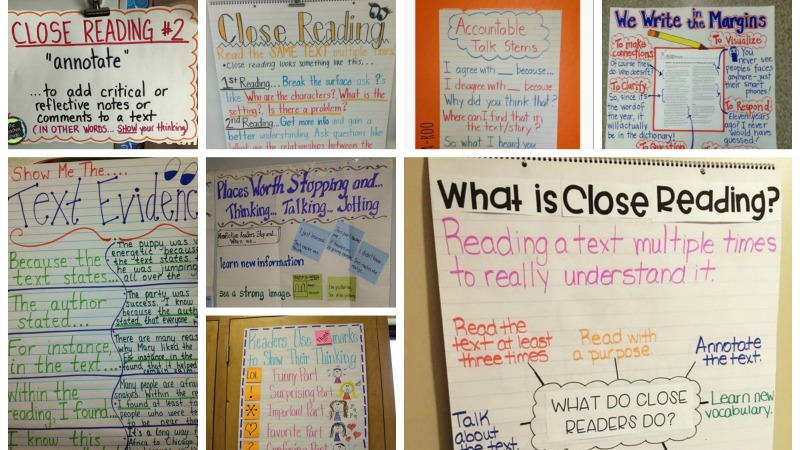
Close reading means reading a text multiple times and using strategies to understand the text’s deeper meaning. To help you teach close reading, here is a round up of some of our favorite close reading anchor charts.
Start with a definition.
Introduce the steps of close reading to your students with this anchor chart.
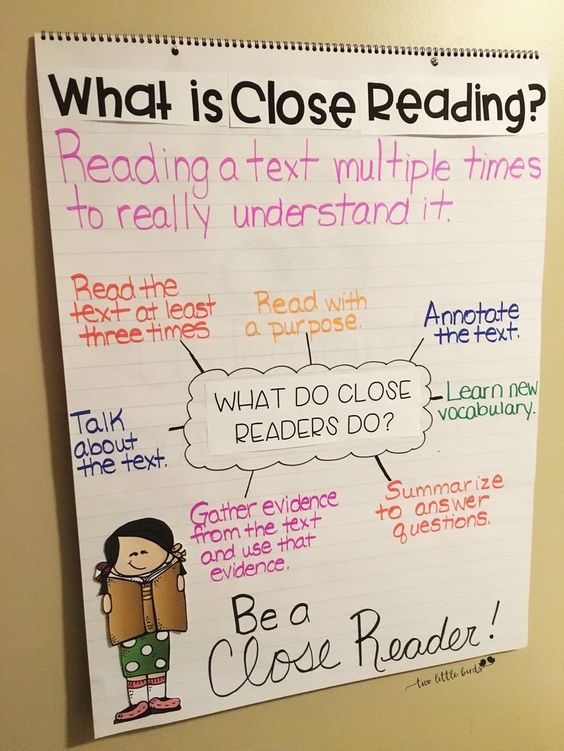
SOURCE: Two Little Birds
This chart lays out the process nicely.
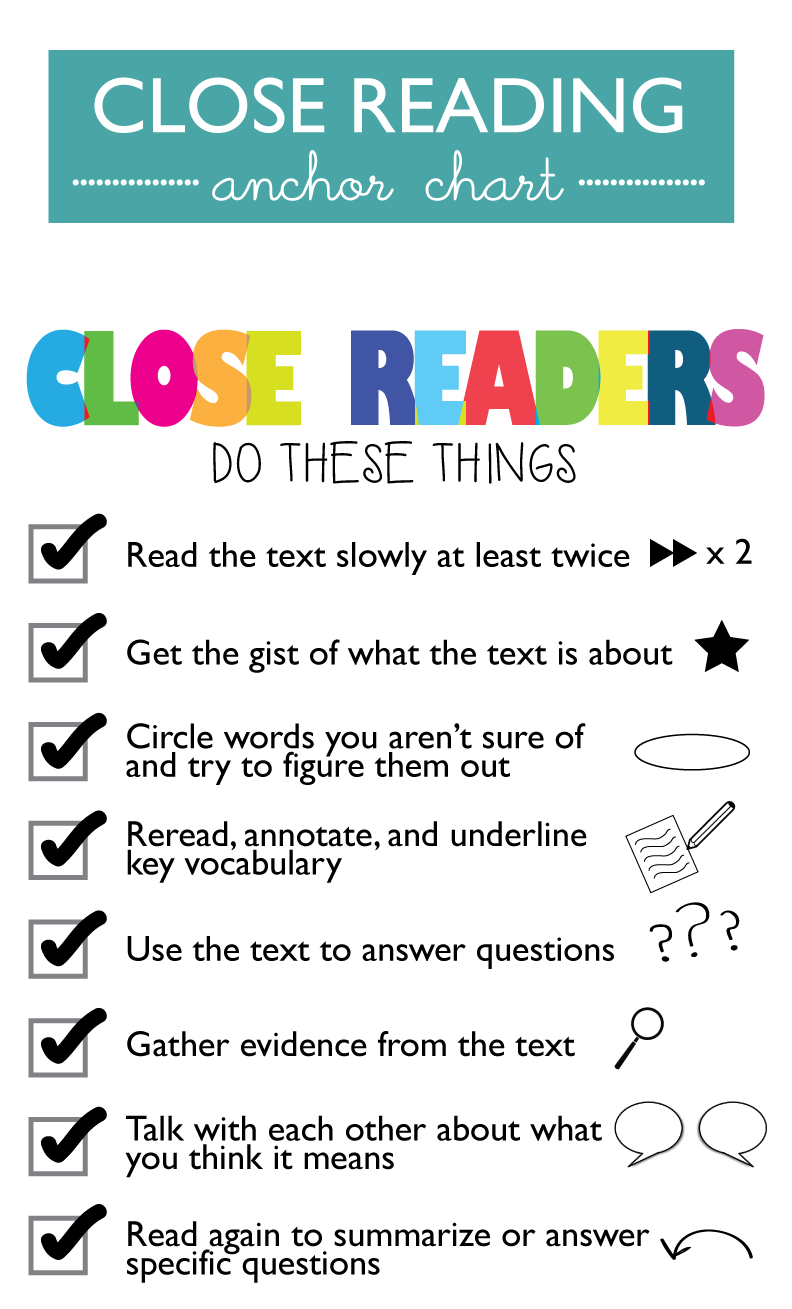
SOURCE: Ms. Houser
Close reading is reading a text multiple times.
These anchor charts explain how and why students read the text multiple times.
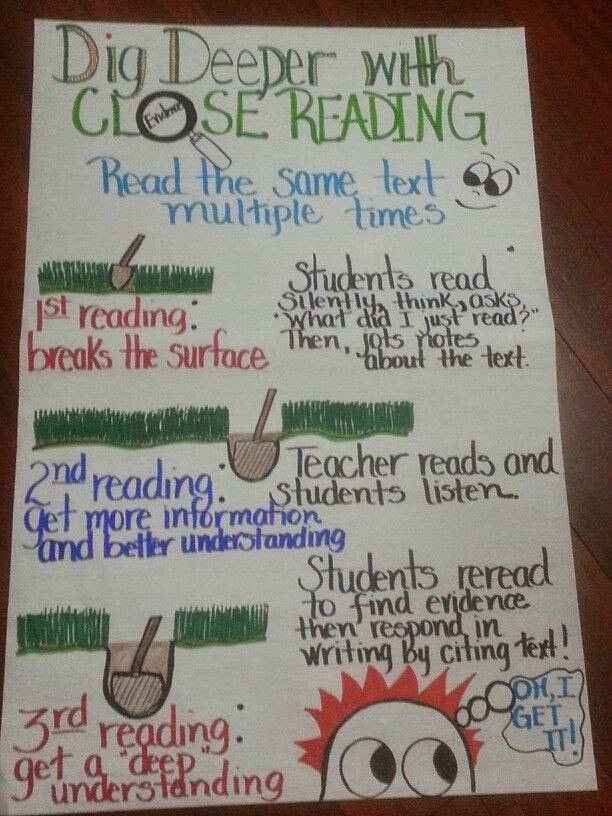
SOURCE: Elementary Nest
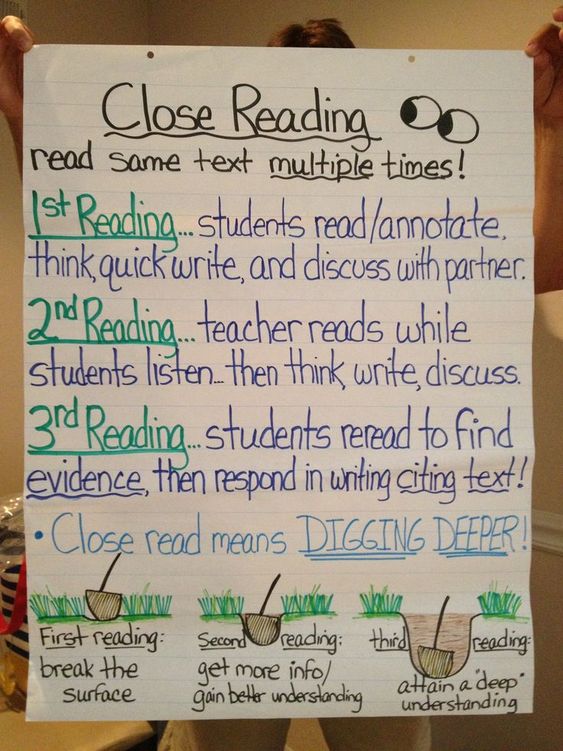
SOURCE: Tara’s Fourth Grade Frolics
This chart gives students questions to think about as they read.
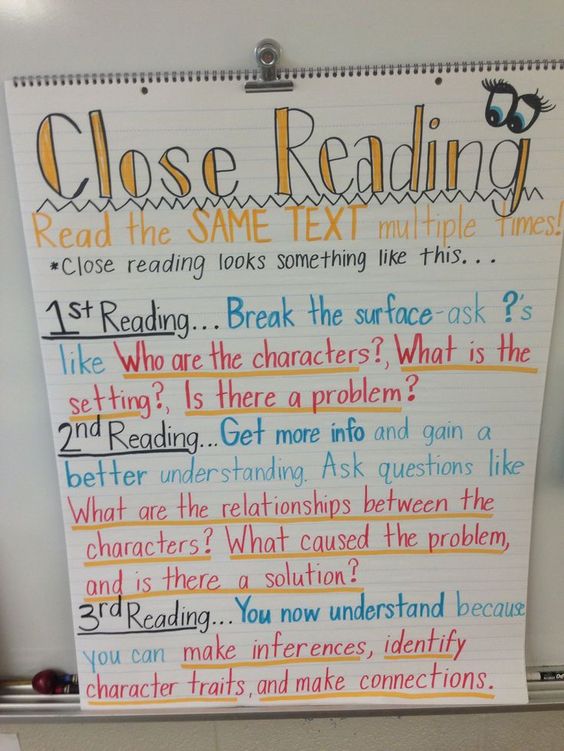
SOURCE: Wise Guys
[contextly_auto_sidebar]
Read with purpose.
Questions reader should be asking themselves as they read.
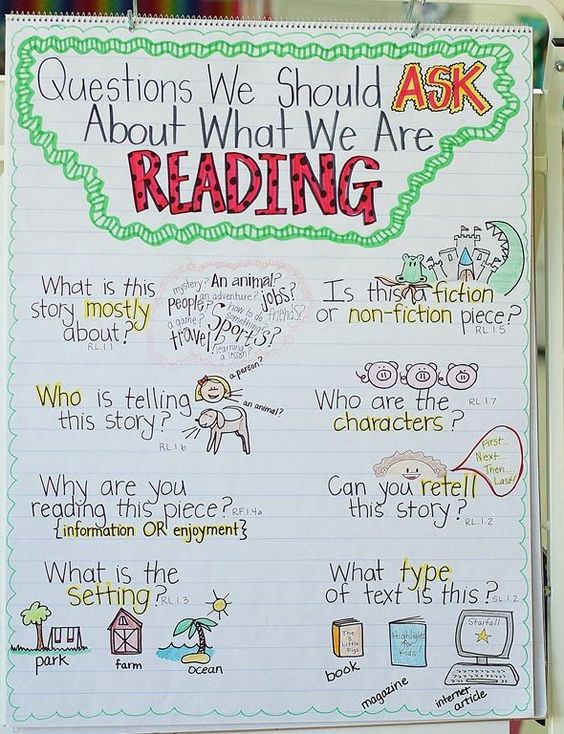
SOURCE: Fern Smith’s Classroom Ideas
Take notes as you read.
Annotate, or in other words take notes, to show your thinking. There are many methods for annotating—from using basic marks and highlighting to writing in the margins and using sticky notes. Write down any vocabulary words that are new to you.
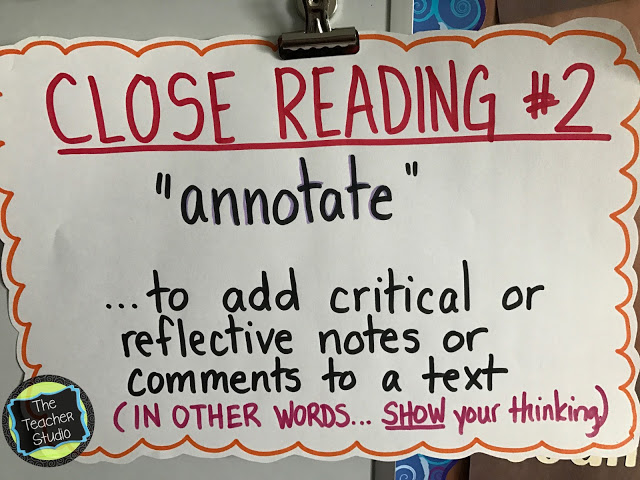
SOURCE: The Teacher Studio
Use simple annotation marks.
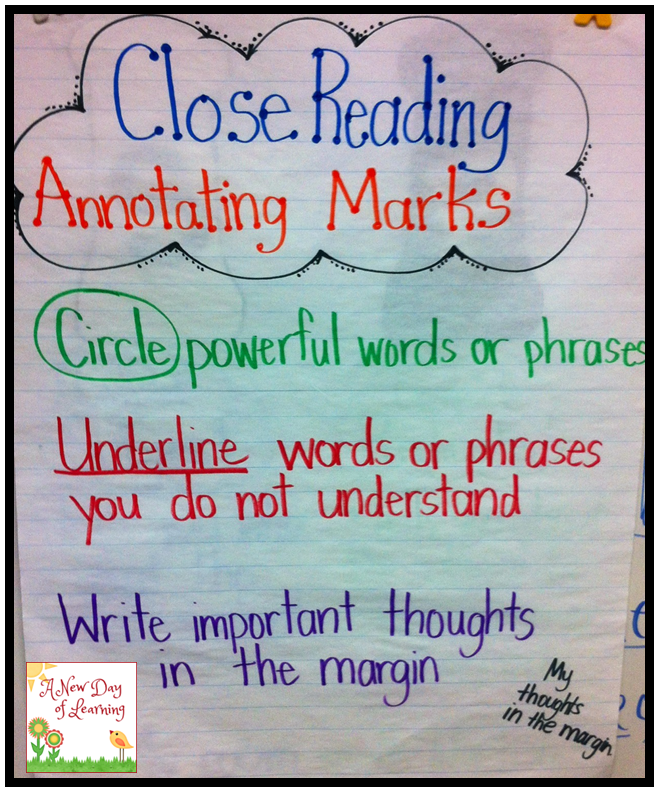
SOURCE: A New Day of Learning
Use sticky notes.
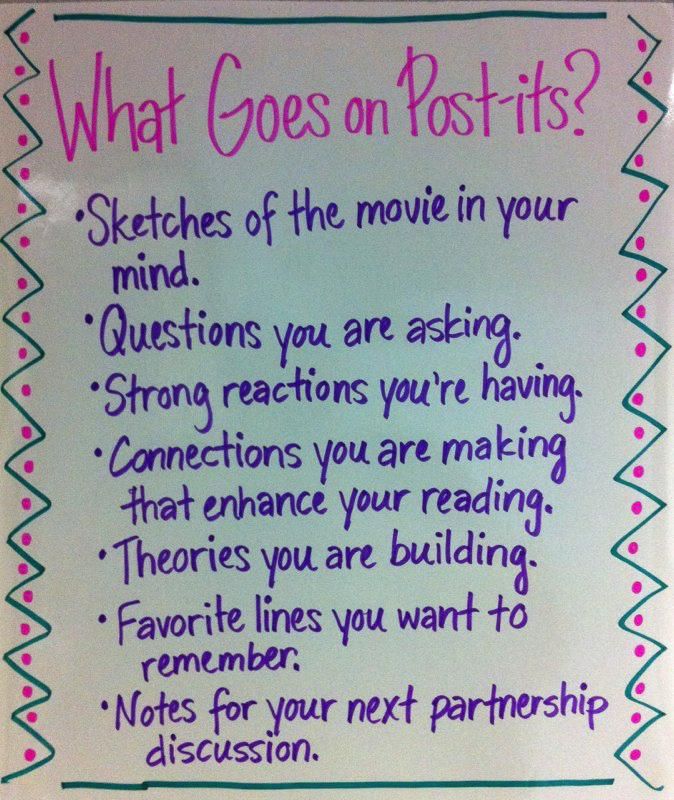
SOURCE: Mrs. Quimby Reads
Think marks are one strategy for taking notes.
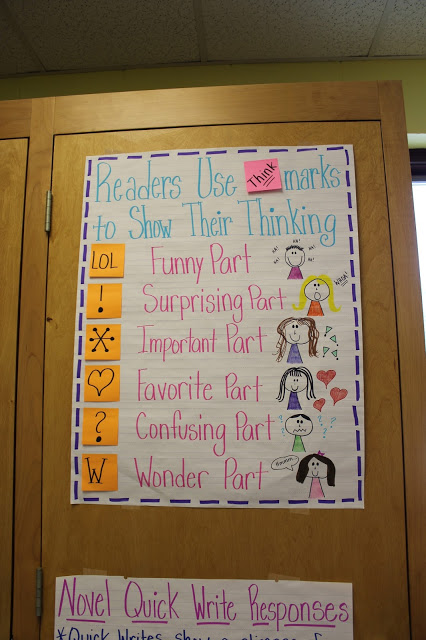
SOURCE: Life in Fifth Grade
Annotating symbols that students can write on copies of the text or on sticky notes.
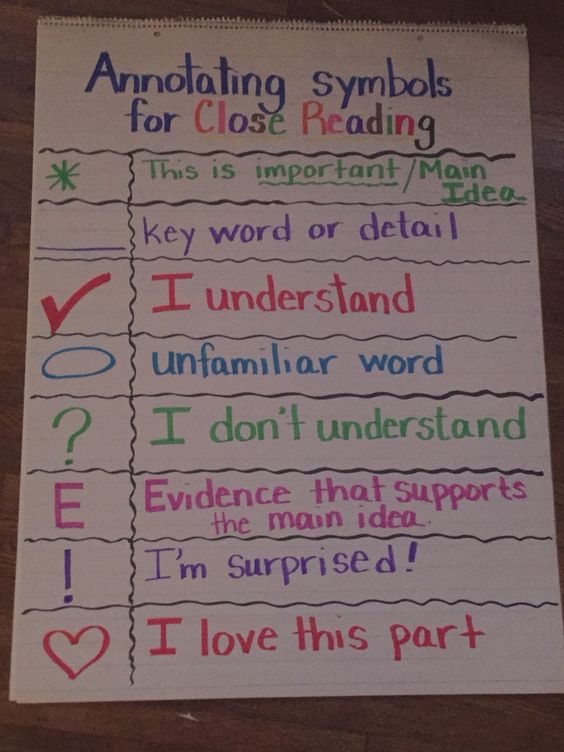
SOURCE: Pinterest
Another version.
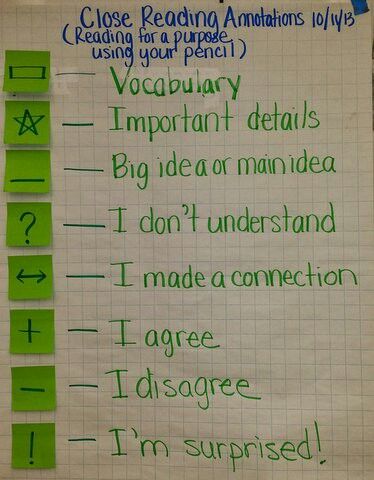
And yet another.
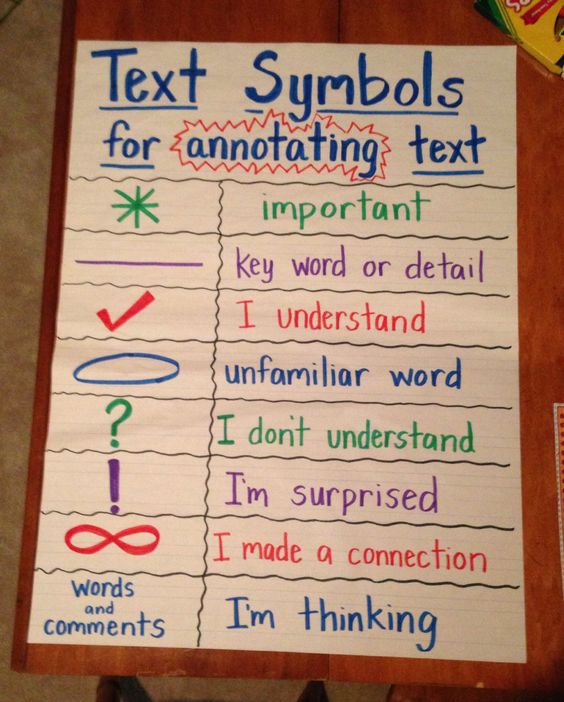
This chart shows why it is important to take notes.
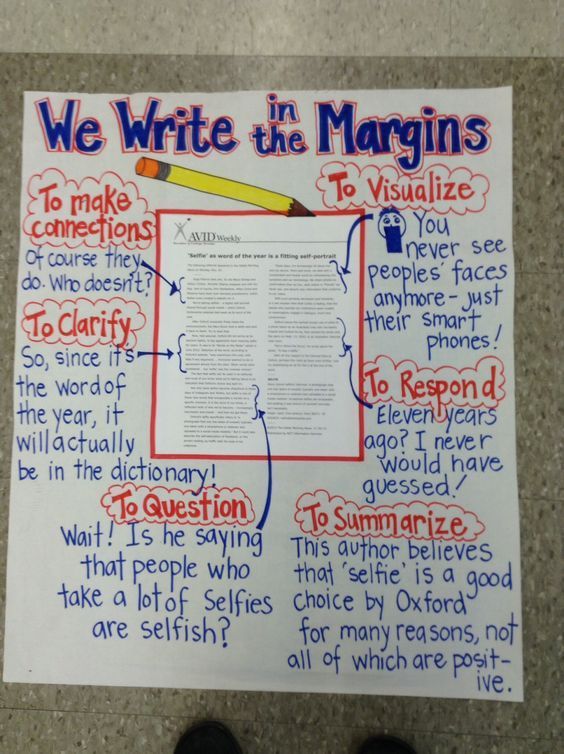
SOURCE: Pinterest
This anchor chart points when it is important to stop and take notes.
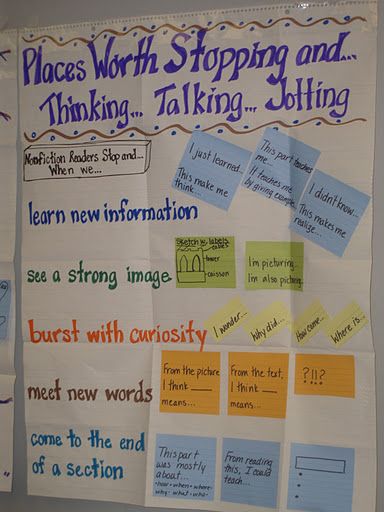
Summarize to answer questions.
When students read a longer text, it’s helpful to break it into sections, writing a summary sentence for each section.
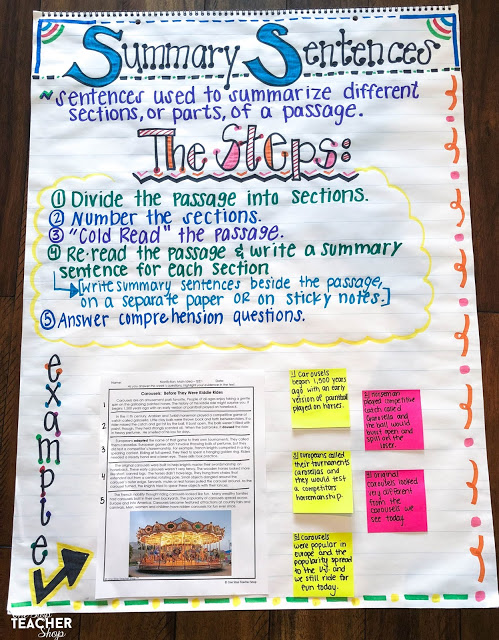
SOURCE: Upper Elementary Snapshots
This anchor chart shows how to pick out basic ideas in a text.

SOURCE: ELA in the Middle
Search for evidence.
As students take notes, they are gathering evidence from the text to answer questions.
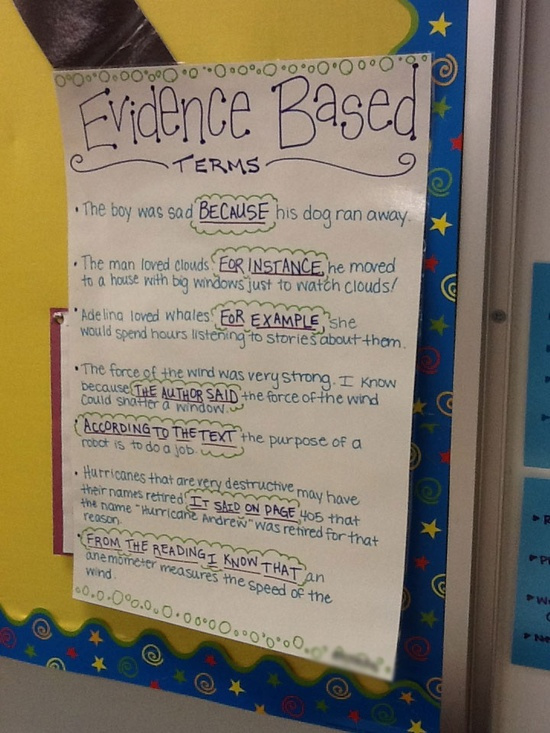
This anchor chart gives students sentence starters to find evidence in a text.
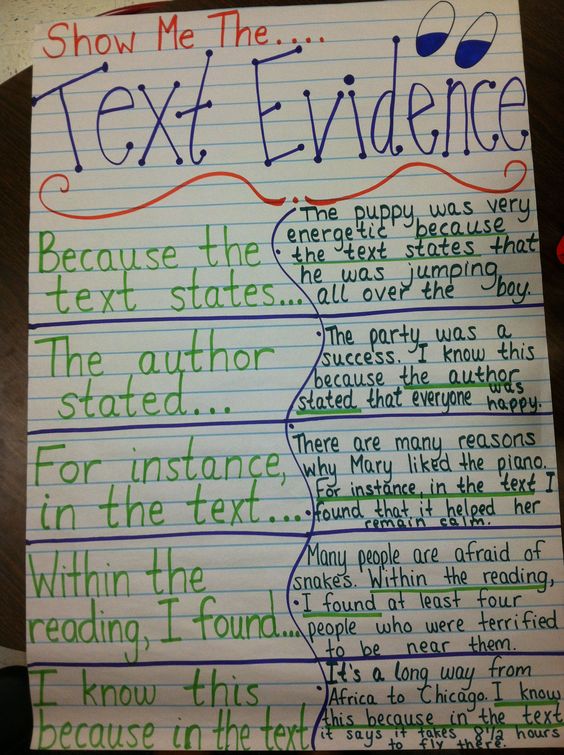
SOURCE: Usazconvention
This chart shows key words to use when stating evidence.
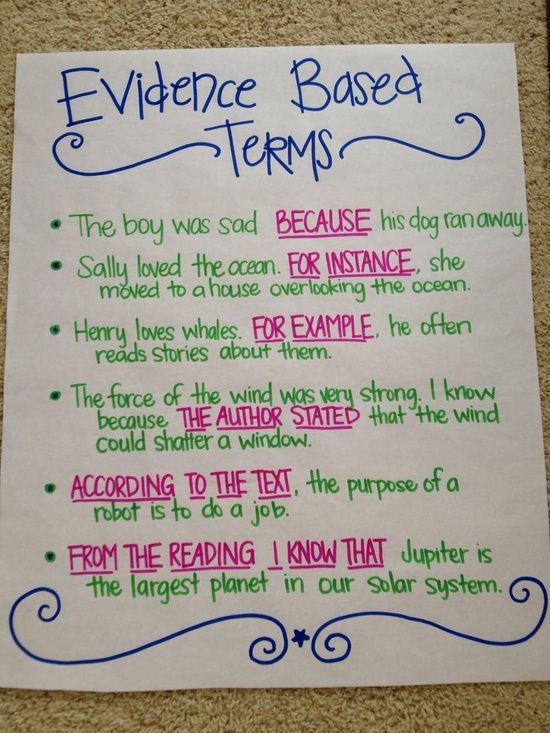
SOURCE: How To Do It
Talk about what you’ve read.
An important part of the close reading process is talking about what you’ve read. This anchor chart gives students language to talk with a partner.
SOURCE: Teach-a-Roo
This anchor chart gives students language to share their point of view.
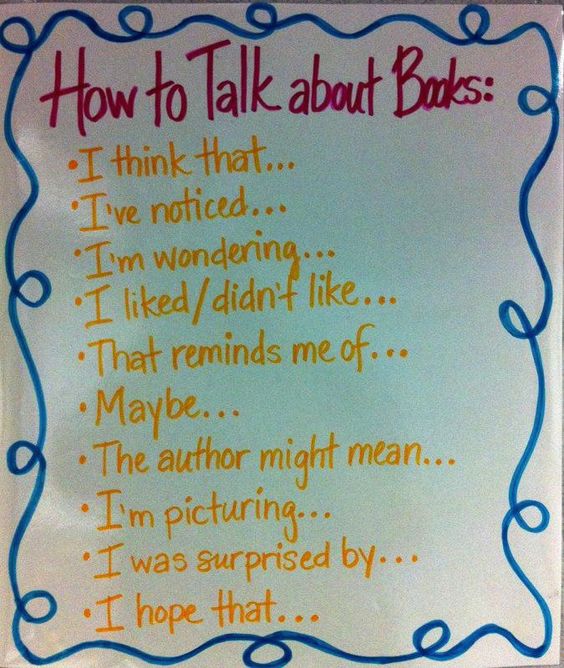
SOURCE: Julie Ballew
More conversation starters.

SOURCE: Life in 4B
What are your go-to close reading anchor charts? Come share in our WeAreTeachers HELPLINE group on Facebook.
Also, check out our favorite nonfiction and reading comprehension anchor charts.
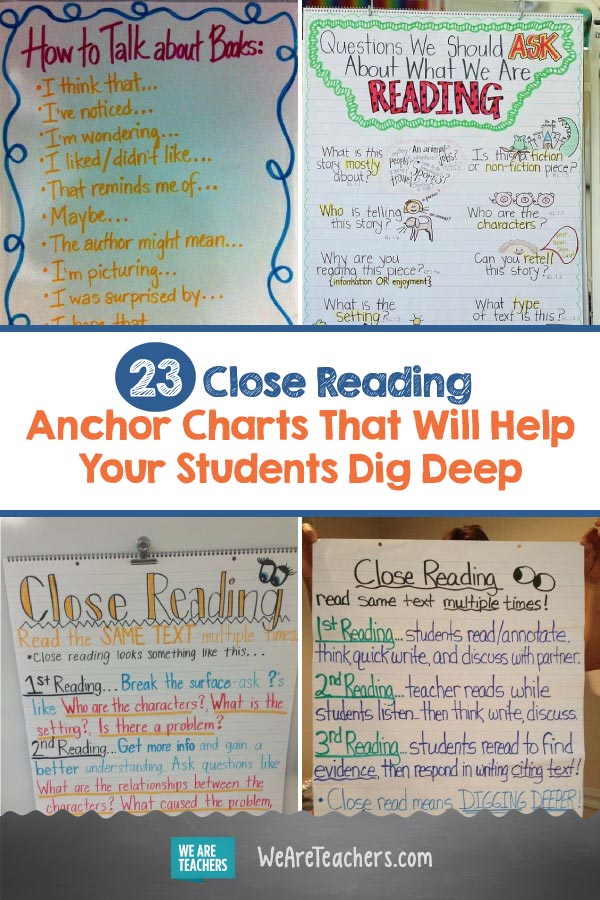
You Might Also Like
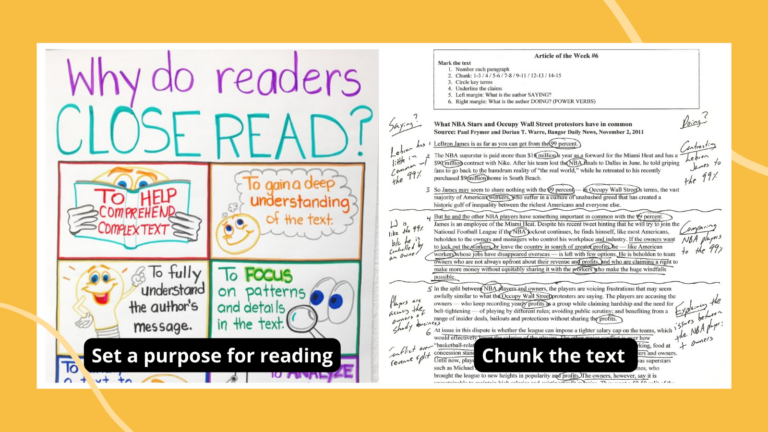
Close Reading Strategies: A Step-by-Step Teaching Guide
Slow down, think, annotate, and reflect. Continue Reading
Copyright © 2024. All rights reserved. 5335 Gate Parkway, Jacksonville, FL 32256

How to Assess Close Reading
- Reading Instruction
Yesterday, Danielle Valentin asked me a great question on Twitter : What’s the best way to assess close reading?
According to Beth Burke, NBCT , close reading “is thoughtful, critical analysis of a text that focuses on significant details or patterns in order to develop a deep, precise understanding of the text…”
In other words, close reading engages in a meaningful dialogue with the text. Oftentimes, we facilitate that conversation through annotation. But Carol Jago and Penny Kittle remind us that “Annotation is not close reading; it is a habit of the mind.”
This post this post may contain affiliate links . Please read the Terms of Use .
Similarly, Dave Stuart Jr. reminds us that annotation is only valuable when it has purpose. This means, as teachers, we must intentionally plan for how annotation will appear in our lessons.
Additionally, we must also make sure students understand the purpose for annotation in our lessons. If we incorporate annotation into our lessons in service of close reading, then we must ask ourselves how the assessment measures students’ ability to close read. Therefore, we must return to Danielle’s original question: how do we assess close reading?
With that question in mind, here are 5 Dos and 1 Don’t for assessing close reading:
How to start.
DO model close reading and share your thinking with students. Before students can begin the process of close reading with rigor, it’s important to walk students through the process. Let them see and hear your dialogue with a text.
My favorite ways to support close reading involve using easy-to-remember systems. For poetry, I use this system and these tools . And for informational and nonfiction texts, I use this system and these tools .
For my juniors, I model close reading with the first paragraphs of Jonathan Edwards’ “ Sinners in the Hands of an Angry God .” Choose a text that presents frequent opportunities for students to wrestle with meaning. Build in an opportunity for you to self-assess your work in front of students. So you are modeling the reflection process for them, too.
DO invite dialogue. My absolute #teachertruth is that reading is a conversation, and writing is a social activity. With this philosophy in mind, I fully believe that close reading is a conversation with a text. Students have to bring their insights into the text and make room for the text’s impact.
For Peter Elbow , this is the “violence” involved in learning: to make sure that both student and text are “maximally transformed–in a sense, deformed” (331). Close reading should invite a chorus, a cacophony, a conversation!
Incorporate meaningful academic discussion into your lesson. Ask students to establish some behavior norms for discussion. But then let them dig into the text together. The assessment comes from your observations, student responses to each other, and student responses to your questions.

Use Close Reading to Support Assessment
DO use close reading as formative assessment . While my students are discussing a text, I ask them to have their annotations out. As they chat, I walk around and read through annotations. If annotation is your tool for assessing close reading, then you have to be reading over students’ annotations to make sure they balance critical thought with comprehension. This can be a hard balance to strike, which is why modeling is so important.
As I walk, I star great insights and write questions where students missed an opportunity to extend thought further. After a discussion, I encourage students to share their reflections on their annotations. If I consistently see a student struggling to create meaningful annotations, I will do a mini-lesson and reteach as needed.
DO use close reading as a platform for summative assessment. Close reading draws on inference , analysis, synthesis , and evaluation skills! Because close reading requires so many higher-level skills, it is a great platform for diving into a summative assessment.
In writing, close reading is an important part of peer revisions and feedback. But the summative assessment is the writing.
During Socratic Seminar, close reading is essential to generating meaningful questions. But the questions and dialogue are the summative assessment.
In reading, close reading is critical to providing a nuanced poetry study . But student responses to the poem (maybe in the form of multiple-choice questions or a short answer) are the summative assessment.
Get Creative
DO incorporate voice and choice into close reading. In my classroom, close reading almost always means annotation. However, instead of insisting that students use one standard annotation format, we experiment with a variety of formats: double-entry journals , Cornell notes , and post-it-notes .
Sometimes we annotate digitally , use Screencastify , or mark directly on a piece . After students try a certain number of annotation styles, they can choose the one that fits their needs and their mind. Invite creativity into this process!
But annotation isn’t the only marker of close reading. Students can complete exit tickets, color-code a text, design graphic organizers, free write, or journal . Each one of these items can be an assessment of close reading.
Assess Close Reading Without Grading
DON’T grade close reading. Close reading improves student comprehension, engagement, and higher-level thinking. However, close reading is not the summative assessment. So there’s no need to put a grade on close reading. Remember, “grading” and “assessment” are not synonymous.
As Carnegie Mellon University indicates, assessment seeks to “improve student learning” while grading is evaluative. Close reading is an assessment of how well a student interacted with a text and can be measured with annotation. However, the goal of close reading, like the goal of assessment, is to improve student learning. Grade the final copy. Grade the Socratic Seminar. And grade the item, task, or product that shows the culmination of student learning.
What close-reading strategies work in your classroom? What other questions do you have for Moore English? Send your questions, and remember to subscribe for new posts every week.

Photo by Debby Hudson and Kelly Sikkema on Unsplash
Read these posts next...

20 Tortured Poets for Your High School English Classroom

7 Engaging Anthologies for Your High School Classroom Library

3 Nonfiction Text Pairings for To Kill a Mockingbird

Five Years Of Nerdy Posts: I Am Who My Students Think

Let's Stay in Touch
Join Moore English


The Barker Underground
Writing advice from the harvard college writing center tutors, how to close read a film.
by Nathan Roberts, Departmental Writing Fellow in Art, Film, and Visual Studies
Departmental Writing Fellows offer discipline-specific writing support to students taking courses in that department. This post is adapted from a handout Nathan shared at a recent workshop on close reading film for students in AFVS.
Step 1: Decide what to focus on depending on your assignment.
- Are you working on a film review or critique? For a critique, it will typically be important to pay attention to the overall structure of the film , as well as salient details .
- This lends a paper care and focus and helps avoid the temptation of summary or plot analysis.
- When choosing specific scenes, you still need to consider their place and function within the film as a whole. Ask: what sequences complicate or even contradict the reading of one specific scene? (Ex: “somewhere over the rainbow” vs. “there’s no place like home.”)
Step 2: Set watching goals depending on how many times you will be able to watch the film.
If it’s a rare film or a film that will only be shown once, I suggest these goals:
- Consume a good amount of caffeine–but not too much.
- Warm up by watching anything by the director/featuring the actor/etc. that’s readily available. This will attune you toward issues of style, interests, etc.
- Take notes in the dark about all salient features that you notice. This will help activate your mind and your attention. Don’t worry if these are readable when writing– the main goal here is developing an active mind and memory. As soon as the film ends, leave the theater and try to decipher your notes. Write down/type out as much as you remember.
If the film is readily available, and you’re writing a paper on it, I suggest that you watch it several times.
First watch: Note striking elements.
On the first watch of all films watched for a class, note only the aspects that stand out most to you. Focus on aspects that seem strange, weird, unusual captivating . Writing these down can keep your active attention , without expending too much mental energy on your paper. Most people find this kind of intense energy hard to sustain, especially if the film is long, and so they eventually give up writing notes all together. Noting the most striking elements will help you know which films you want to write about – trust your instincts to propel you further into your paper.
Second watch: Note the film’s formal features.
In this watch, note all the salient formal features that stand out to you.
What are formal features? Features related to how the film is uniquely crafted as a cinematic object.
• Film formal features to start with : storyboarding elements (camera angles: wide shot, medium shot, close up, extreme close up, etc. memorize them. Then camera moving: left, right, up, down, track, pan, dolly, rack focus, etc.)
• Then think about: what’s in the frame, what does the frame focus on?
• Then consider: issues of editing: cuts, rhythm, order of shots, etc.
• Then posit : sound – most people don’t attend to sound. Sound can give you a major analytical advantage if you pay attention to it – many scholars don’t
Try to list as many film formal features as you can! Don’t be afraid to be obvious/mechanical with our observation at this point.
Tip: when it comes to things like lighting or other more ephemeral aspects, YouTube or Vimeo will be extremely helpful. People have made video essays dealing with almost all of these film formal features. (If you can and you have filmmaker friends, try to get on a set, even the set of a student film.)
How can you learn more formal features?
• Yale Film Analysis guide. Detailed GIFS, etc. The more you know, the better.
When it comes to things like lighting or other more ephemeral aspects, YouTube or Vimeo will be extremely helpful. People have made video essays dealing with almost all of these film formal features. (If you can and you have filmmaker friends, try to get on a set, even the set of a student film.)
Third watch: Think about what these elements do in a sequence or in the film.
An easy way to think about this is to ask yourself: “how could this have been filmed differently, and why”.
Tip : If you have access to a digital copy of the film, edit out specific scenes, or crop shots… play with what’s on the screen. If you’re thinking about sound, mute the soundtrack and see how this changes things.
Or : Play your own soundtrack under the sequence to see how this changes the tonality or affect of the sequence.
If you’re thinking about temporal spread, rhythm, compression, etc., use a stopwatch to think about how long sequences are. (In the middle sequence of an action film, for instance, you may discover that the sequence is edited faster than earlier sequences, but not as fast as later sequences. This will be useful.)
Think about how the accumulation of edited scenes make meaning. ( The Kuleshov Effect.)
Final watch: Think about what these elements mean–not necessarily what they represent.
Sometimes symbols do exist in films, but asking what the film enacts or exemplifies gets you beyond the secondary quality of representation.
Representation (symbolization, etc.) tends to point toward something external to the text, something beyond what you’re reading. Enacting or exemplification does not. It does something in the world through the film; it creates something that does not necessarily exist outside of the film. And, crucially, it allows one to analyze elements that are not necessarily intentionally placed in the film by creators .
This final step will often leave you with a contestable claim or argument––and that is ok. That is the point of making arguments and engaging in academic dialogue and discourse.
Your claims should be, by this point, based firmly in how the film is constructed and what it is doing. Your close reading observations therefore put you in an immediate position of authority and allow you to make strong claims. Your approach forces potential intellectual opponents to return to the text, and argue from turf that you’ve already trodden. Therefore, your close reading has immediately made arguments that are grounded and productive.
If you are an undergraduate enrolled in a film course you can discuss a draft of any assignment with the DWF. Schedule an office hour appointment here!
Share this:, leave a comment.

- Already have a WordPress.com account? Log in now.
- Subscribe Subscribed
- Copy shortlink
- Report this content
- View post in Reader
- Manage subscriptions
- Collapse this bar
Doyle Online Writing Lab
Close reading assignments.
"A close reading (or Explication de texte) operates on the premise that any artistic creation will be more fully understood and appreciated to the extent that the nature and interrelations of its parts are perceived, and that that understanding will take the form of insight into the theme of the work in question. This kind of work must be done before you can begin to appropriate any theoretical or specific approach." 1
To explicate comes from the Latin explicare, to unfold, to fold out, or to make clear the meaning of. When you close read, you observe facts and details about the text. Your aim is to notice all striking features of the text, including rhetorical features, structural elements, cultural references or allusions. A close reading should be more than a list of devices, though. The essay should move from observation of particular facts and details to a conclusion, or interpretation, based on those observations. What do these data add up to mean? 2
Close reading has three primary objectives.
It encourages you to be a better and more careful reader.
It asks you to employ the tools you heard used in lecture and probably have employed yourself in conference: analysis of speaker, diction, figurative language, sound, and genre to name a few.
- It engages you in the act of synthesis. Even as you divide the passage or object poem into its composite elements, you will want to discuss how those elements come together to form a whole.
Requirements: What does a Close Reading Essay Usually Have?
A thesis that is an assertion about the meaning and function of the text . It must be something you can argue for and prove in your essay.
Evidence from the text . What specific words or phrases led you to have the ideas you express? Quote them.
Analysis of that evidence . If the work were self-evident you could just turn in the book or image as your proof. Literally thousands of people have had thousands of different ideas about the words or details you mention. Explain how you arrived at your ideas.
Need More Help?
See the following pages:
- How to Annotate
- Close Readings of Passages
- Close Readings of Visual Artifacts
1 The Literary Link. Ed. Janice E. Patten. June 2, 1998. San Jose State University Web Site. 17 Sept. 2003. . 2 Patricia Kain, "How to Do a Close Reading," 1998. Harvard University Writing Center Web Site . 17 Sept. 2003. 3 Diane Hacker. The Bedford Handbook for Writers, 3rd. ed. Boson: Bedford Books of St. Martin's Press, 1991. 91.

IMAGES
VIDEO
COMMENTS
Close reading is deep analysis of how a literary text works; it is both a reading process and something you include in a literary analysis paper, though in a refined form. Fiction writers and poets build texts out of many central components, including subject, form, and specific word choices. Literary analysis involves examining these ...
This post from a former special education teacher describes six characteristics you might look for when selecting a close reading passage from a novel: beginnings, pivotal plot points, character changes, high-density passages, "Q&A" passages, and "aesthetic" passages. "Close Reading Passages" (Reading Sage)
Here's how to use picture books in close reading lessons. 2. Prepare students by teaching annotation. Source: The English Classroom. Close reading will require some prep work. Students have to know how to annotate effectively, pulling out and making notes on the most important parts, i.e., not highlighting everything.
Close Reading for English Literature Assignments What is a close reading? A close reading is a very in-depth, careful analysis of a short text. This text can be a passage selected from a novel, a poem, an image, a short story, etc. The analysis looks carefully at
This guide outlines close reading, including what it is, how to do it, and strategies to practice. top of page. Email: [email protected] Phone: 650-430-8087 (text or call) ... Close reading is more than just a classroom assignment-it's a reading method that helps you analyze and comprehend all texts.
Close Reading! Close reading is an important tool for writing an essay and doesn't have to be as overwhelming as it sounds. Here are some tips to make it easy and effective. ... close read the parts which address an aspect of your essay or assignment. Doing so will help you understand the subtleties in the passage that will help you add ...
Techniques for Close Reading Reading a text in preparation for an academic assignment or for studying for an exam can be much different than casual reading. Close reading means being an active reader—reading, rereading, annotating, and looking for connections between texts (if you are working with multiple texts).
Getting started. Before you can write your close reading essay, you need to read the text that you plan to examine at least twice (but often more than that). Follow the above guidelines to break down your close reading into multiple parts. Once you've read the text closely and made notes, you can then create a short outline for your essay.
The parts of the close reading will depend on the type of assignment. You might be asked to do something like the following: Write a formal essay with an introduction, body, and conclusion that closely examines elements from a text or passage and explains their importance or effect. Write a paragraph or series of paragraphs examining a passage ...
Close Reading a Text. Use these "tracking" methods to yield a richer understanding of the text and lay a solid ground work for your thesis. Use a highlighter, but only after you've read for comprehension. The point of highlighting at this stage is to note key passages, phrases, turning points in the story. Pitfalls:
Step 4: Construct an argument about the passage. Now that you have some idea of HOW language is being used in your passage, you need to connect this to the larger themes of the text. In other words, you now need to address WHY language is being used in the way (or ways) you have observed. This step is essential to a successful close reading.
Fisher & Frey (2012) remind us that "the practice of close reading is not a new one, and in fact has existed for many decades as the practice of reading a text for a level of detail not used in everyday reading" (p. 8). Buckley (2011) explains that "as English teachers, we have to empower all our students to use texts to construct and ...
Assignment: Close Reading. Overview. A close reading is a study of the detail in a short section of a text and an explanation of how that detail and that section are related to the entire text. In thinking about literature, you should always refer back to the detail of a text as well as to its grander effects. The project requires critical ...
Close reading is an integral and essential component of the common core standards. Close reading asks students to not only read a text for basic comprehension and understanding, but to really read the text, dig deeply into the text, and make connections with the text. Here is a look at close reading strategies that are effective and engaging in the middle school ELA and high school English ...
5. Mind Mirror. Sample of a Mind Mirror. For a creative, artistic approach to close reading students can create mind mirrors. This works well with readings about people (leaders, philosophers, etc) as well as economic and political theories (communist, capitalism, absolute monarchy, etc.)
Close Reading: How to Choose Passages. Choose passages to focus on character development: choose 3-5 passages that help to establish how the character changes over the course of the text. This works great with novels and short stories. An easy way to do this with a play by Shakespeare is to focus on the soliloquies.
Example close reading. Below is an example of a close reading written for the module by a now-graduated student. It demonstrates how to focus on the text and balance close reading with cultural context (although is slightly longer than the essays we now ask you to write). Percy Bysshe Shelley, 'Mont Blanc' (ll. 1-48) (Chloe Todd-Fordham) In A ...
Talk about what you've read. An important part of the close reading process is talking about what you've read. This anchor chart gives students language to talk with a partner. SOURCE: Teach-a-Roo. This anchor chart gives students language to share their point of view. SOURCE: Julie Ballew.
According to Beth Burke, NBCT, close reading "is thoughtful, critical analysis of a text that focuses on significant details or patterns in order to develop a deep, precise understanding of the text…". In other words, close reading engages in a meaningful dialogue with the text. Oftentimes, we facilitate that conversation through annotation.
Departmental Writing Fellows offer discipline-specific writing support to students taking courses in that department. This post is adapted from a handout Nathan shared at a recent workshop on close reading film for students in AFVS. Step 1: Decide what to focus on depending on your assignment.
Close Reading Assignments. "A close reading (or Explication de texte) operates on the premise that any artistic creation will be more fully understood and appreciated to the extent that the nature and interrelations of its parts are perceived, and that that understanding will take the form of insight into the theme of the work in question.
reading assignment for homework. (Note: This homework assignment will not count as one of the close readings of the text; the teacher will conduct a close read of specific sections during class; however, students must read the entire text for full comprehension.) Close Reading and Instruction 5. 1st Reading (Reading for Key Ideas and Details)
Close Reading Assignment of the Gettysburg Address The "Gettysburg Address" written and spoken by President Lincoln is still one of the most popular speeches of all time. His speech had a powerful opening which was him not first addressing the audience by thanking them for being there or acknowledging their presence which was something ...